The Glacial Geomorphology of the Ice Cap Piedmont Lobe Landsystem of East Mýrdalsjökull, Iceland
Abstract
1. Introduction
2. Methods
3. The Sandfellsjökull and Oldufellsjökull Piedmont Lobes
4. Glacial Geomorphology and Surficial Geology of the Glacier Forelands
4.1. Till and Moraines
4.2. Glacifluvial Deposits
4.3. Glacilacustrine Deposits Modified by Glacifluvial Processes
5. Glacial Landsystems and Their Relationships to Glacier Dynamics
6. Conclusions
Supplementary Materials
Author Contributions
Funding
Acknowledgments
Conflicts of Interest
References
- Krüger, J. Glacial processes, sediments, landforms and stratigraphy in the terminus region of Mýrdalsjökull, Iceland. Folia Geogr. Danica 1994, 21, 1–233. [Google Scholar]
- Andrzejewski, L. The impact of surges on the ice-marginal landsystem of Tungnaárjökull, Iceland. Sediment. Geol. 2002, 149, 59–72. [Google Scholar] [CrossRef]
- Evans, D.J.A.; Twigg, D.R. The active temperate glacial landsystem: A model based on Breidamerkurjokull and Fjallsjokull, Iceland. Quat. Sci. Rev. 2002, 21, 2143–2177. [Google Scholar] [CrossRef]
- Evans, D.J.A.; Twigg, D.R.; Shand, M. Surficial geology and geomorphology of the Þorisjökull plateau icefield, west-central Iceland. J. Maps 2006, 2, 17–29. [Google Scholar] [CrossRef]
- Evans, D.J.A.; Twigg, D.R.; Rea, B.R.; Shand, M. Surficial geology and geomorphology of the Bruarjökull surging glacier landsystem. J. Maps 2007, 3, 349–367. [Google Scholar] [CrossRef]
- Evans, D.J.A.; Shand, M.; Petrie, G. Maps of the snout and proglacial landforms of Fjallsjökull, Iceland (1945, 1965, 1998). Scott. Geogr. J. 2009, 125, 304–320. [Google Scholar]
- Evans, D.J.A.; Twigg, D.R.; Rea, B.R.; Orton, C. Surging glacier landsystem of Tungnaárjökull, Iceland. J. Maps 2009, 5, 134–151. [Google Scholar] [CrossRef]
- Evans, D.J.A.; Nelson, C.D.; Webb, C. An assessment of fluting and till esker formation on the foreland of Sandfellsjökull, Iceland. Geomorphology 2010, 114, 453–465. [Google Scholar] [CrossRef]
- Evans, D.J.A.; Ewertowski, M.; Orton, C. Fláajökull (north lobe), Iceland: Active temperate piedmont lobe glacial landsystem. J. Maps 2016, 12, 777–789. [Google Scholar] [CrossRef]
- Evans, D.J.A.; Ewertowski, M.; Orton, C. Eiriksjökull plateau icefield landsystem, Iceland. J. Maps 2016, 12, 747–756. [Google Scholar] [CrossRef]
- Evans, D.J.A.; Ewertowski, M.; Orton, C.; Harris, C.; Guðmundsson, S. Snæfellsjökull volcano-centred ice cap landsystem, Iceland. J. Maps 2016, 12, 1128–1137. [Google Scholar] [CrossRef]
- Evans, D.J.A.; Ewertowski, M.; Orton, C. Skaftafellsjökull, Iceland: Glacial geomorphology recording glacier recession since the Little Ice Age. J. Maps 2017, 13, 358–368. [Google Scholar] [CrossRef]
- Evans, D.J.A.; Ewertowski, M.; Orton, C. The glaciated valley landsystem of Morsarjökull, southeast Iceland. J. Maps 2017, 13, 909–920. [Google Scholar] [CrossRef]
- Kjær, K.H.; Korsgaard, N.J.; Schomacker, A. Impact of multiple glacier surges—A geomorphological map from Brúarjökull, east Iceland. J. Maps 2008, 4, 5–20. [Google Scholar] [CrossRef]
- Bennett, G.L.; Evans, D.J.A.; Carbonneau, P.; Twigg, D.R. Evolution of a debris-charged glacier landsystem, Kvıarjokull, Iceland. J. Maps 2010, 2010, 40–76. [Google Scholar] [CrossRef]
- Schomacker, A.; Benediktsson, I.O.; Ingolfsson, O. The Eyjabakkajökull glacial landsystem, Iceland: Geomorphic impact of multiple surges. Geomorphology 2013, 218, 98–107. [Google Scholar] [CrossRef]
- Jónsson, S.A.; Schomacker, A.; Benediktsson, Í.Ö.; Ingólfsson, Ó.; Johnson, M.D. The drumlin field and the geomorphology of the Múlajökull surge type glacier, central Iceland. Geomorphology 2014, 207, 213–220. [Google Scholar] [CrossRef]
- Jónsson, S.A.; Benediktsson, I.O.; Ingolfsson, I.; Schomacker, A.; Bergsdottir, H.L.; Jacobson, W.R.; Linderson, H. Submarginal drumlin formation and late Holocene history of Fláajökull, southeast Iceland. Ann. Glaciol. 2016, 57, 128–141. [Google Scholar] [CrossRef]
- Evans, D.J.A.; Orton, C. Heinabergsjökull and Skalafellsjökull, Iceland: Active Temperate Piedmont Lobe and Outwash Head Glacial Landsystem. J. Maps 2015, 11, 415–431. [Google Scholar] [CrossRef]
- Everest, J.; Bradwell, T.; Jones, L.D.; Hughes, L. The geomorphology of Svínafellsjökull and Virkisjökull-Falljökull glacier forelands, southeast Iceland. J. Maps 2017, 13, 936–945. [Google Scholar] [CrossRef]
- Björnsson, H.; Pálsson, F.; Sigurðsson, O.; Flowers, G.E. Surges of glaciers in Iceland. Ann. Glaciol. 2003, 36, 82–90. [Google Scholar] [CrossRef]
- Þórarinsson, S. The jökulhlaup from the Katla area in 1955 compared with other Jökulhlaups in Iceland. Jökull 1957, 7, 21–25. [Google Scholar]
- Evans, D.J.A.; Rea, B.R. Geomorphology and sedimentology of surging glaciers: A landsystems approach. Ann. Glaciol. 1999, 28, 75–82. [Google Scholar] [CrossRef]
- Evans, D.J.A. Geomorphology and retreating glaciers. In Treatise on Geomorphology; Shroder, J., Giardino, R., Harbor, J., Eds.; Academic Press: San Diego, CA, USA, 2013; Volume 8, pp. 460–478. [Google Scholar]
- Evans, D.J.A.; Archer, S.; Wilson, D.J.H. A comparison of the lichenometric and Schmidt hammer dating techniques based on data from the proglacial areas of some Icelandic glaciers. Quat. Sci. Rev. 1999, 18, 13–41. [Google Scholar] [CrossRef]
- Evans, D.J.A.; Twigg, D.R.; Orton, C. Satujökull glacial landsystem, Iceland. J. Maps 2010, 6, 639–650. [Google Scholar] [CrossRef]
- Sigbjarnason, G. Katla and Askja. Jökull 1973, 23, 45–50. [Google Scholar]
- Sæmundsson, K. Öskjur á virkum eldfjallasvæðum á Íslandi. (Calderas in active volcanic regions in Iceland). In Eldur er í Norðri; Sögufélag: Reykjavík, Iceland, 1982; pp. 221–239. [Google Scholar]
- Þórarinsson, S. Katla og annáll Kötlugosa. (Katla and annals of Katla eruptions). In Árbók Ferðafélags Íslands; Ferðafélags Íslands: Reykjavík, Iceland, 1975; pp. 125–149. [Google Scholar]
- Rist, S. The thickness of the ice cover of Mýrdalsjökull, Southern Iceland. Jökull 1967, 17, 237–242. [Google Scholar]
- Rist, S. Jökulhlaups from the ice cover of Mýrdalsjökull on June 25, 1955 and January 20, 1956. Jökull 1967, 17, 243–248. [Google Scholar]
- Maizels, J.K. Sedimentology, palaeoflow dynamics and flood history of jökulhlaup deposits: Palaeohydrology of Holocene sediment sequences in southern Iceland sandur deposits. J. Sediment. Petrol. 1989, 59, 204–223. [Google Scholar]
- Maizels, J.K. Boulder ring structures produced during jokulhlaup flows: Origin and hydraulic significance. Geogr. Ann. 1992, 74A, 21–33. [Google Scholar] [CrossRef]
- Maizels, J.K. Lithofacies variations within sandur deposits: The role of runoff regime, flow dynamics and sediment supply characteristics. Sediment. Geol. 1993, 85, 299–325. [Google Scholar] [CrossRef]
- Karlsson, Þ. Kötluhlaupið 1918, vangaveltur um eðli hlaupsins og hámarksrennsli. (The 1918 Katla jökulhlaup—Characteristics and peak discharge). In Kötlustefna; Ágrip Erinda; Jarðfræðafélag Íslands: Reykjavík, Iceland, 1994; pp. 10–12. [Google Scholar]
- Tómasson, H. The jökulhlaup from Katla in 1918. Ann. Glaciol. 1996, 22, 249–254. [Google Scholar] [CrossRef]
- Larsen, G. Holocene eruptions within the Katla volcanic system, Iceland: Notes on characteristics and environmental impact. Jökull 2000, 49, 1–28. [Google Scholar]
- Björnsson, H.; Pálsson, F.; Guðmundsson, M.T. Surface and bedrock topography of the Mýrdalsjökull ice cap. Jökull 2000, 49, 29–46. [Google Scholar]
- Björnsson, H. Jöklar á Íslandi; Bokautgafan Opna: Reykjavik, Iceland, 2009. [Google Scholar]
- Krüger, J.; Humlum, O. The proglacial area of Mýrdalsjökull with particular reference to Slettjökull and Hofðabrekkujökull: General report on the Danish geomorphological expedition to Iceland 1977. Folia Geographica Danica 1981, 15, 1–56. [Google Scholar]
- Heim, D. Stauchmoränengenese durch die Entwicklung eines “Gletscherfusses” am Kotlujökull, Sudisland. Polarforschung 1984, 54, 21–36. [Google Scholar]
- Humlum, O. Genesis of an imbricate push moraine, Hofðabrekkujökull, Iceland. J. Geol. 1985, 93, 185–195. [Google Scholar] [CrossRef]
- Krüger, J. Formation of a push moraine at the margin of Hofðabrekkujökull, South Iceland. Geogr. Ann. 1985, 67A, 199–212. [Google Scholar]
- Kruger, J.; Kjær, K.H.; van der Meer, J.J.M. From push moraine to single-crested dump moraine during a sustained glacier advance. Nor. Geogr. Tidsskr. 2002, 56, 87–95. [Google Scholar] [CrossRef]
- Humlum, O. Observations on debris in the basal transport zone of Mýrdalsjökull, Iceland. Ann. Glaciol. 1981, 2, 71–77. [Google Scholar] [CrossRef][Green Version]
- Krüger, J. Development of minor outwash fans at Kotlujökull, Iceland. Quat. Sci. Rev. 1997, 16, 649–659. [Google Scholar] [CrossRef]
- Kjær, K.H.; Sultan, L.; Krüger, J.; Schomacker, A. Architecture and sedimentation of outwash fans in front of the Mýrdalsjökull ice cap, Iceland. Sediment. Geol. 2004, 172, 139–163. [Google Scholar] [CrossRef]
- Krüger, J. Moraine-ridge formation along a stationary ice front in Iceland. Boreas 1993, 22, 101–109. [Google Scholar] [CrossRef]
- Krüger, J. Origin, chronology and climatological significance of annual moraine ridges at Mýrdalsjökull, Iceland. Holocene 1995, 5, 420–427. [Google Scholar] [CrossRef]
- Krüger, J. Moraine ridges formed from subglacial frozen-on sediment slabs and their differentiation from push moraines. Boreas 1996, 25, 57–63. [Google Scholar] [CrossRef]
- Matthews, J.A.; Briffa, K.R. The ‘Little Ice Age’: Re-evaluation of an evolving concept. Geogr. Ann. 2005, 87, 17–36. [Google Scholar] [CrossRef]
- Kirkbride, M.P.; Dugmore, A.J. Responses of mountain ice caps in central Iceland to Holocene climate change. Quat. Sci. Rev. 2006, 25, 1692–1707. [Google Scholar] [CrossRef]
- Evans, D.J.A.; Hiemstra, J.F. Till deposition by glacier submarginal, incremental thickening. Earth Surf. Process. Landf. 2005, 30, 1633–1662. [Google Scholar] [CrossRef]
- Boulton, G.S. Push moraines and glacier contact fans in marine and terrestrial environments. Sedimentology 1986, 33, 677–698. [Google Scholar] [CrossRef]
- Chandler, B.M.P.; Evans, D.J.A.; Roberts, D.H. Characteristics of recessional moraines at a temperate glacier in SE Iceland: Insights into patterns, rates and drivers of glacier retreat. Quat. Sci. Rev. 2016, 135, 171–205. [Google Scholar] [CrossRef]
- Chandler, B.M.P.; Evans, D.J.A.; Roberts, D.H. Recent retreat at a temperate Icelandic glacier in the context of the last ~80 years of climate change in the North Atlantic region. Arktos 2016, 2, 24. [Google Scholar] [CrossRef]
- Chandler, B.M.P.; Evans, D.J.A.; Roberts, D.H.; Ewertowski, M.; Clayton, A.I. Glacial geomorphology of the Skálafellsjökull foreland, Iceland: A case study of ‘annual’ moraines. J. Maps 2016, 12, 905–916. [Google Scholar] [CrossRef]
- Lukas, S. Processes of annual moraine formation at a temperate alpine valley glacier: Insights into glacier dynamics and climatic controls. Boreas 2012, 41, 463–480. [Google Scholar] [CrossRef]
- Price, R.J. Moraines at Fjallsjökull, Iceland. Arct. Alp. Res. 1970, 2, 27–42. [Google Scholar] [CrossRef]
- Bradwell, T.; Dugmore, A.J.; Sugden, D.E. The Little Ice Age glacier maximum in Iceland and the North Atlantic Oscillation: Evidence from Lambatungnajökull, southeast Iceland. Boreas 2006, 35, 61–80. [Google Scholar] [CrossRef]
- Boulton, G.S. A theory of drumlin formation by subglacial sediment deformation. In Drumlin Symposium; Menzies, J., Rose, J., Eds.; Balkema: Rotterdam, The Netherlands, 1987; pp. 25–80. [Google Scholar]
- Boulton, G.S.; Hindmarsh, R.C.A. Sediment deformation beneath glaciers: Rheology and sedimentological consequences. J. Geophys. Res. Earth Surf. 1987, 92, 9059–9082. [Google Scholar] [CrossRef]
- Hart, J. Identifying fast ice flow from landform assemblages in the geological record: A discussion. Ann. Glaciol. 1999, 28, 59–66. [Google Scholar] [CrossRef]
- Evans, D.J.A. Till: A Glacial Process Sedimentology; Wiley-Blackwell: Chichester, UK, 2018. [Google Scholar]
- Ely, J.C.; Graham, C.; Barr, I.D.; Rea, B.R.; Spagnolo, M.; Evans, J. Using UAV acquired photography and structure from motion techniques for studying glacier landforms: Application to the glacial flutes at Isfallsglaciären. Earth Surf. Process. Landf. 2017, 42, 877–888. [Google Scholar] [CrossRef]
- Evans, D.J.A.; Rea, B.R. Surging glacier landsystem. In Glacial Landsystems; Evans, D.J.A., Ed.; Arnold: London, UK, 2003; pp. 259–288. [Google Scholar]
- Evans, D.J.A.; Storrar, R.D.; Rea, B.R. Crevasse-squeeze ridge corridors: Diagnostic features of late stage palaeo-ice stream activity. Geomorphology 2016, 258, 40–50. [Google Scholar] [CrossRef]
- Russell, A.J.; Knudsen, O.; Fay, H.; Marren, P.M.; Heinz, J.; Tronicke, J. Morphology and sedimentology of a giant supraglacial, ice-walled, jokulhlaup channel, Skeidarárjökull, Iceland: Implications for esker genesis. Glob. Planet. Chang. 2001, 28, 193–216. [Google Scholar] [CrossRef]
- Burke, M.J.; Woodward, J.; Russell, A.J.; Fleisher, P.J.; Bailey, P.K. Controls on the sedimentary architecture of a single event englacial esker: Skeiðarárjökull, Iceland. Quat. Sci. Rev. 2008, 27, 1829–1847. [Google Scholar] [CrossRef]
- Burke, M.J.; Woodward, J.; Russell, A.J.; Fleisher, P.J.; Bailey, P.K. The sedimentary architecture of outburst flood eskers: A comparison of ground-penetrating radar data from Bering Glacier, Alaska and Skeiðarárjökull, Iceland. Bull. Geol. Soc. Am. 2010, 122, 1637–1645. [Google Scholar] [CrossRef]
- Mannerfelt, C.M. Nagra glacialmorfologiska formelement. Geogr. Ann. 1945, 27, 1–239. [Google Scholar] [CrossRef]
- Mannerfelt, C.M. Marginal drainage channels as indicators of the gradients of Quaternary ice caps. Geogr. Ann. 1949, 31, 194–199. [Google Scholar]
- Syverson, K.M.; Gaffield, G.F.; Mickelson, D.M. Comparison of esker morphology and sedimentology with former ice-surface topography, Burroughs Glacier, Alaska. Bull. Geol. Soc. Am. 1994, 106, 1130–1142. [Google Scholar] [CrossRef]
- McKenzie, G.D.; Goodwin, R.G. Development of collapsed glacial topography in the Adams Inlet area, Alaska, USA. J. Glaciol. 1987, 33, 55–59. [Google Scholar] [CrossRef]
- Benn, D.I. Controls on sedimentation in a Late Devensian ice-dammed lake, Achnasheen, Scotland. Boreas 1989, 18, 31–42. [Google Scholar] [CrossRef]
- Evans, D.J.A. Ice-marginal terrestrial landsystems: Active temperate glacier margins. In Glacial Landsystems; Evans, D.J.A., Ed.; Arnold: London, UK, 2003; pp. 12–43. [Google Scholar]
- Evans, D.J.A. The glacier-marginal landsystems of Iceland. In Iceland: Modern Processes and Past Environments; Caseldine, C.J., Russell, A.J., Harjardottir, J., Knudsen, O., Eds.; Elsevier: Amsterdam, The Netherlands, 2005; pp. 93–126. [Google Scholar]
- Bennett, G.L.; Evans, D.J.A. Glacier retreat and landform production on an overdeepened glacier foreland: The debris-charged glacial landsystem at Kvıarjokull, Iceland. Earth Surf. Process. Landf. 2012, 37, 1584–1602. [Google Scholar] [CrossRef]
- Spedding, N.; Evans, D.J.A. Sediments and landforms at Kvıarjökull, southeast Iceland: A reappraisal of the glaciated valley landsystem. Sediment. Geol. 2002, 149, 21–42. [Google Scholar] [CrossRef]
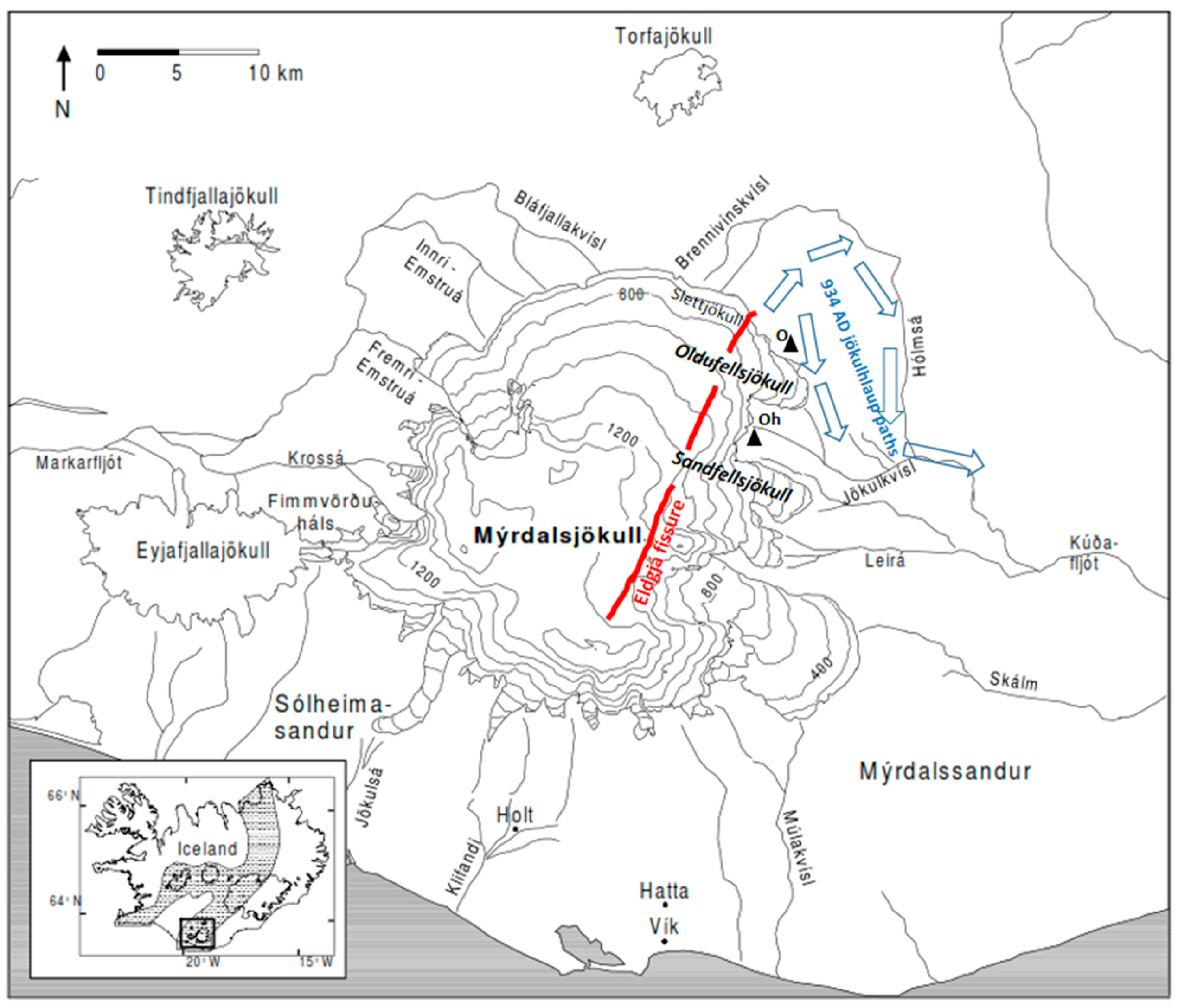
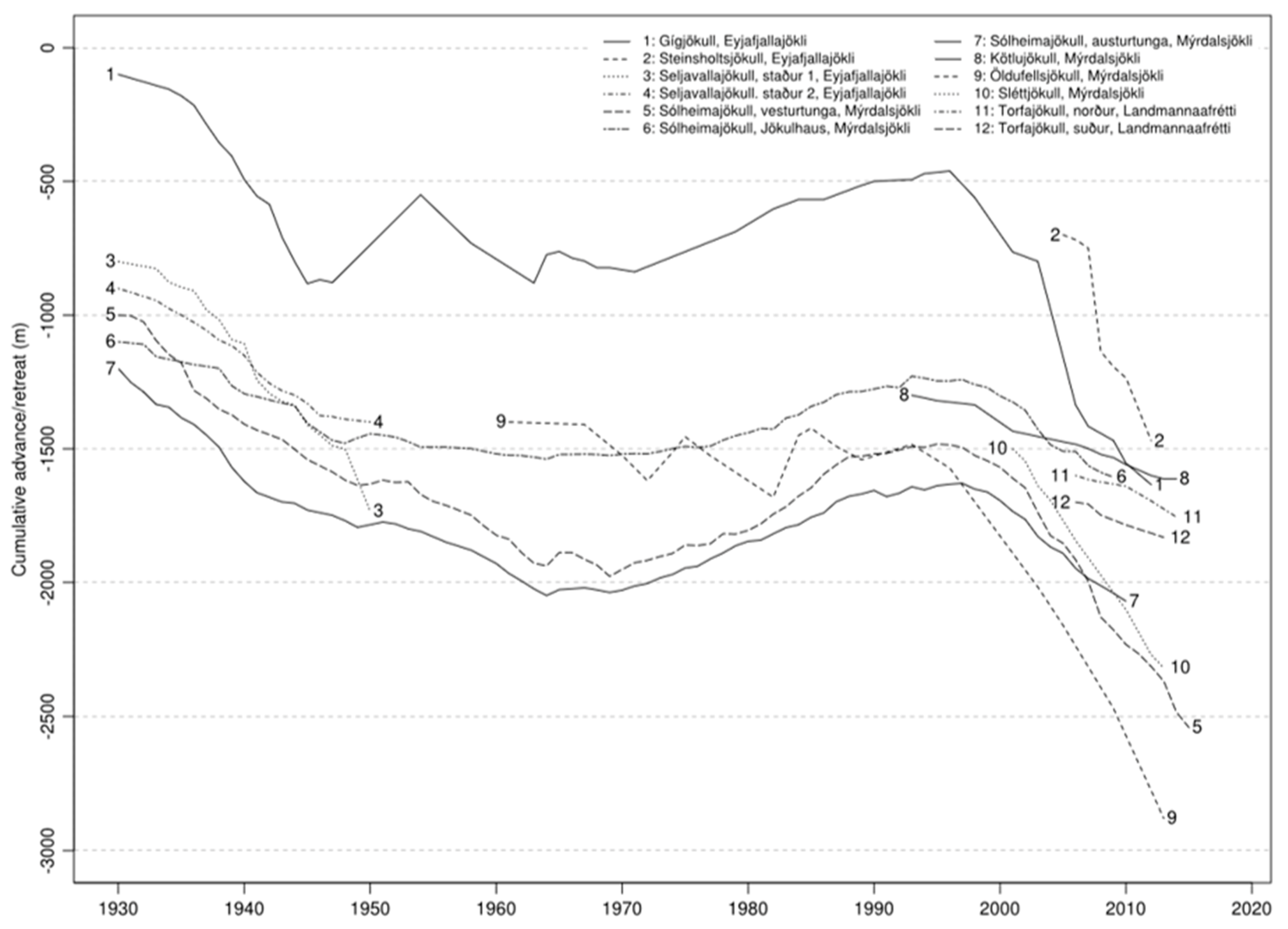
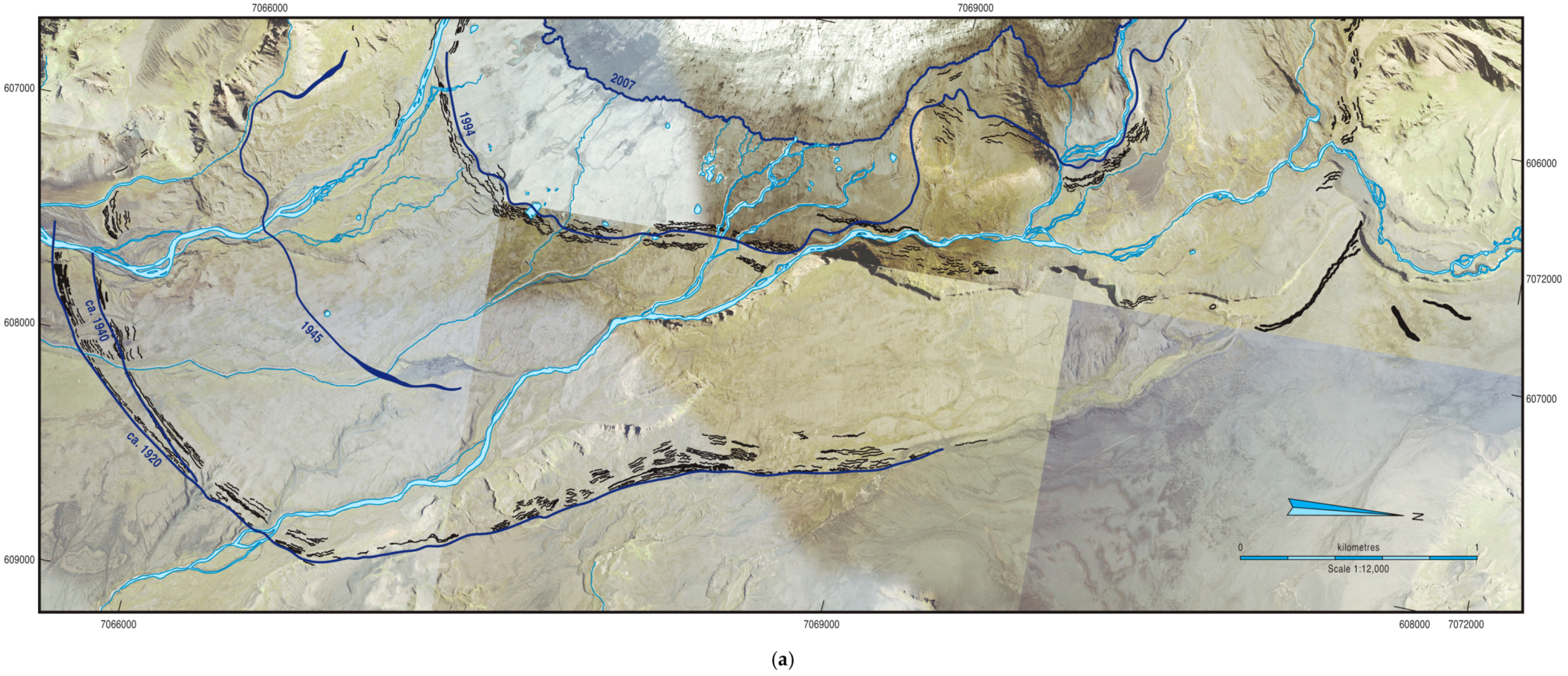
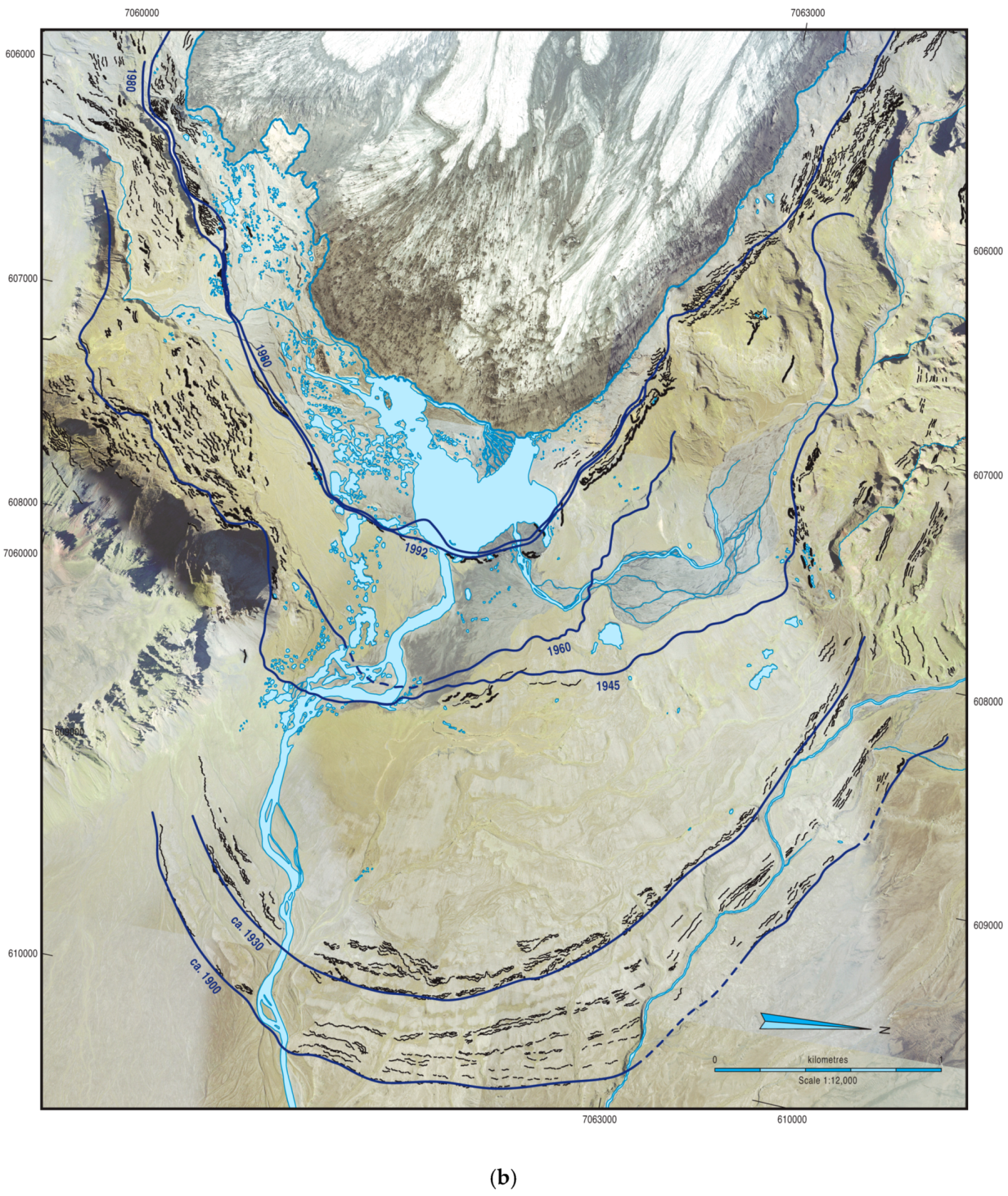
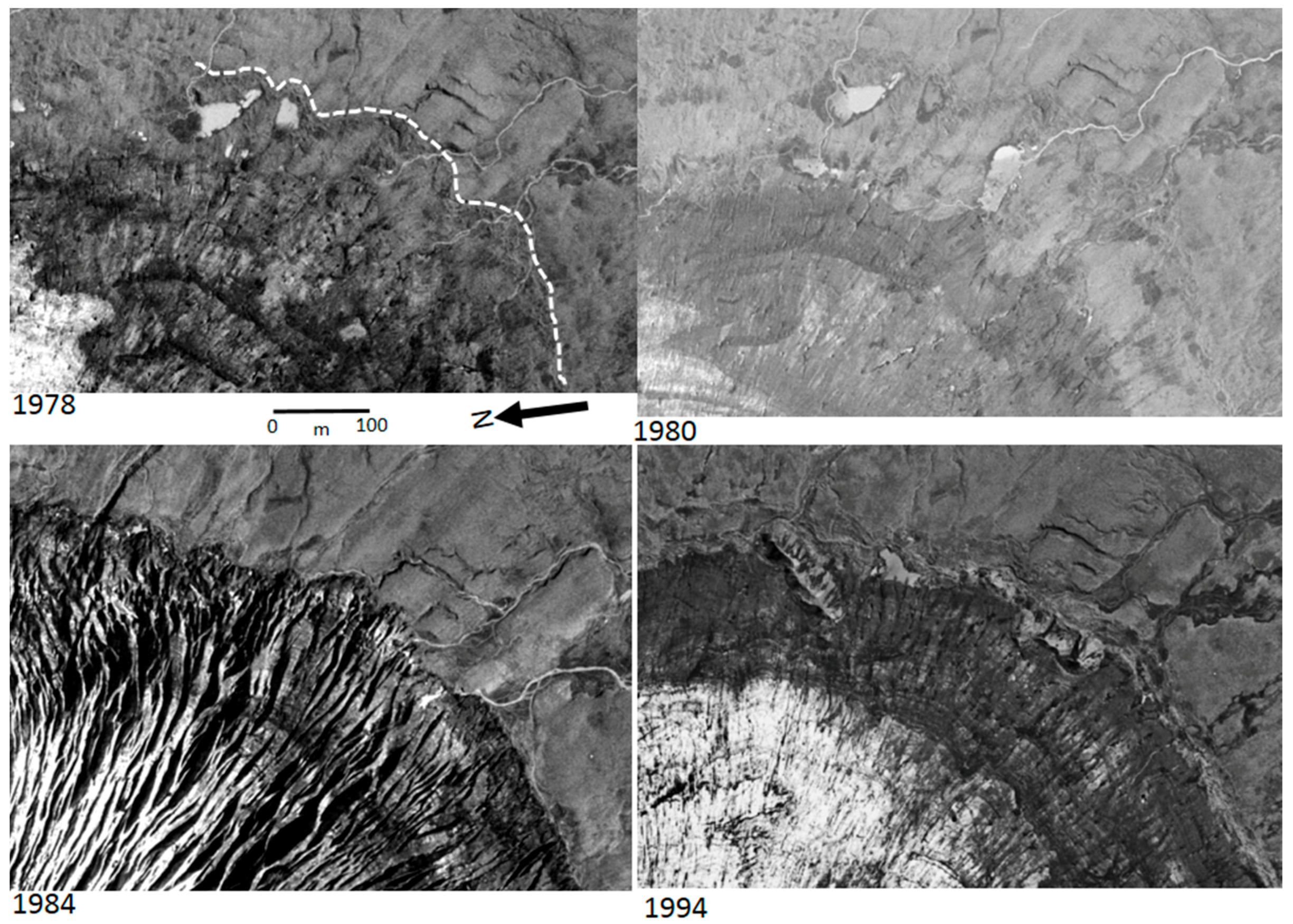
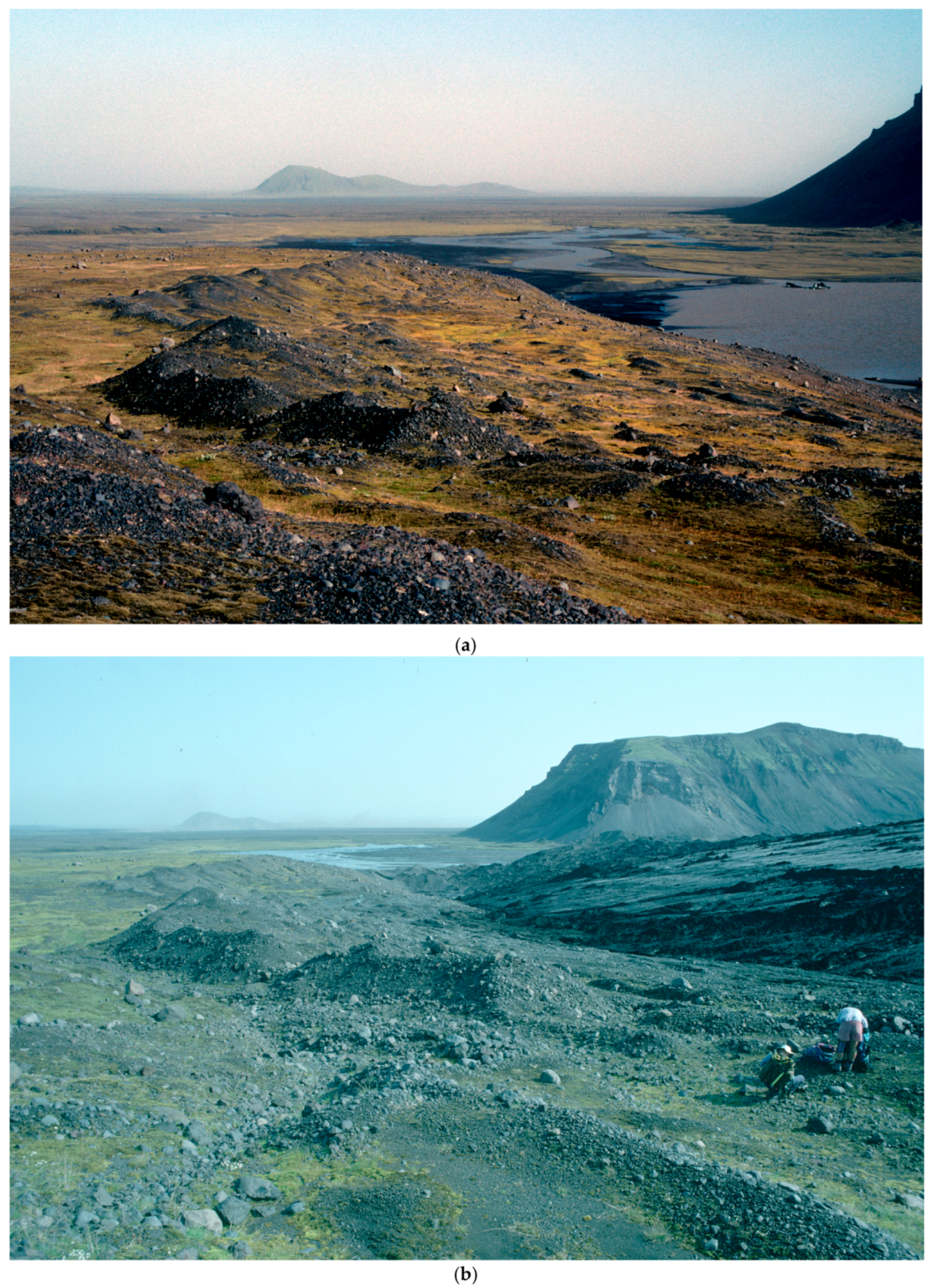
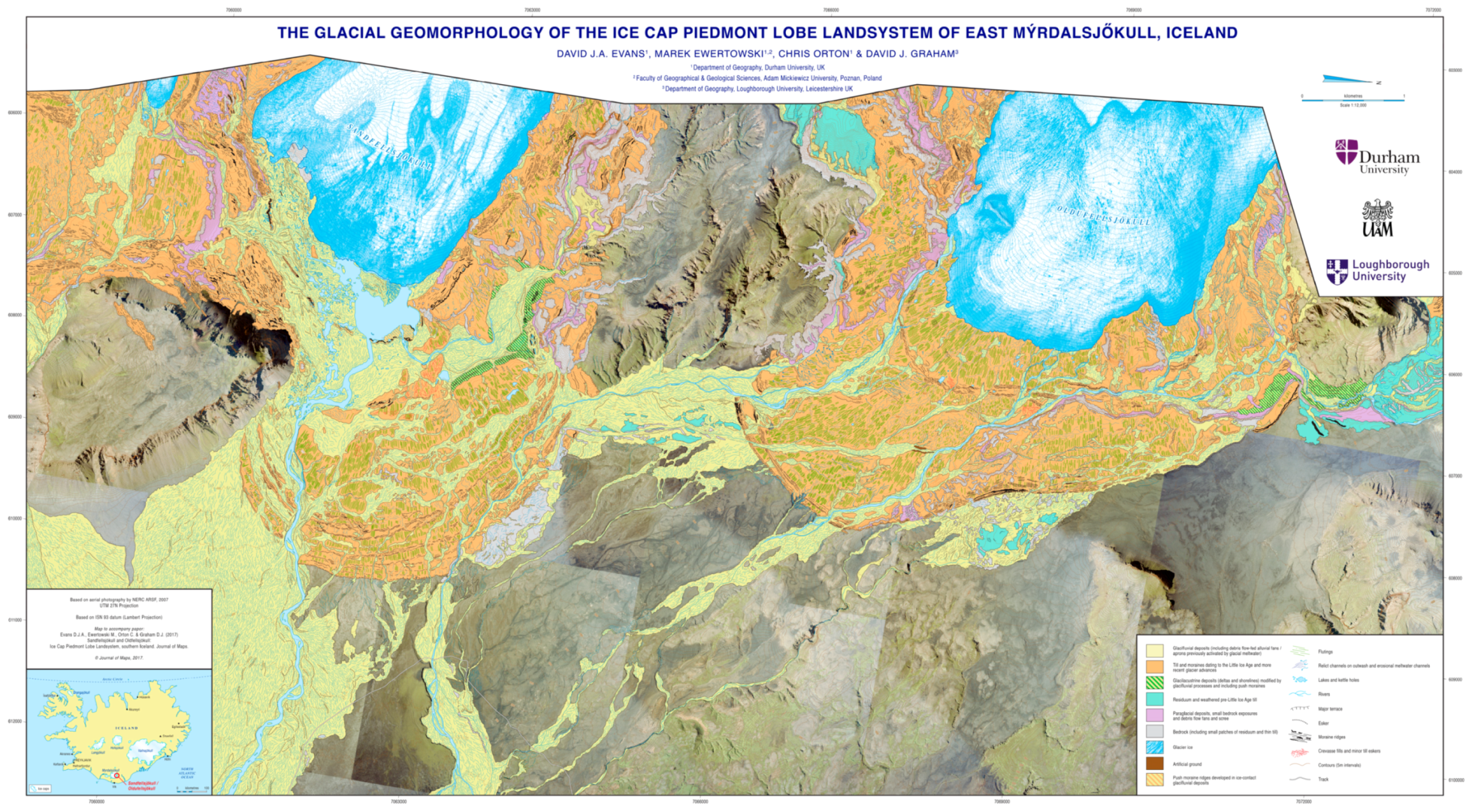
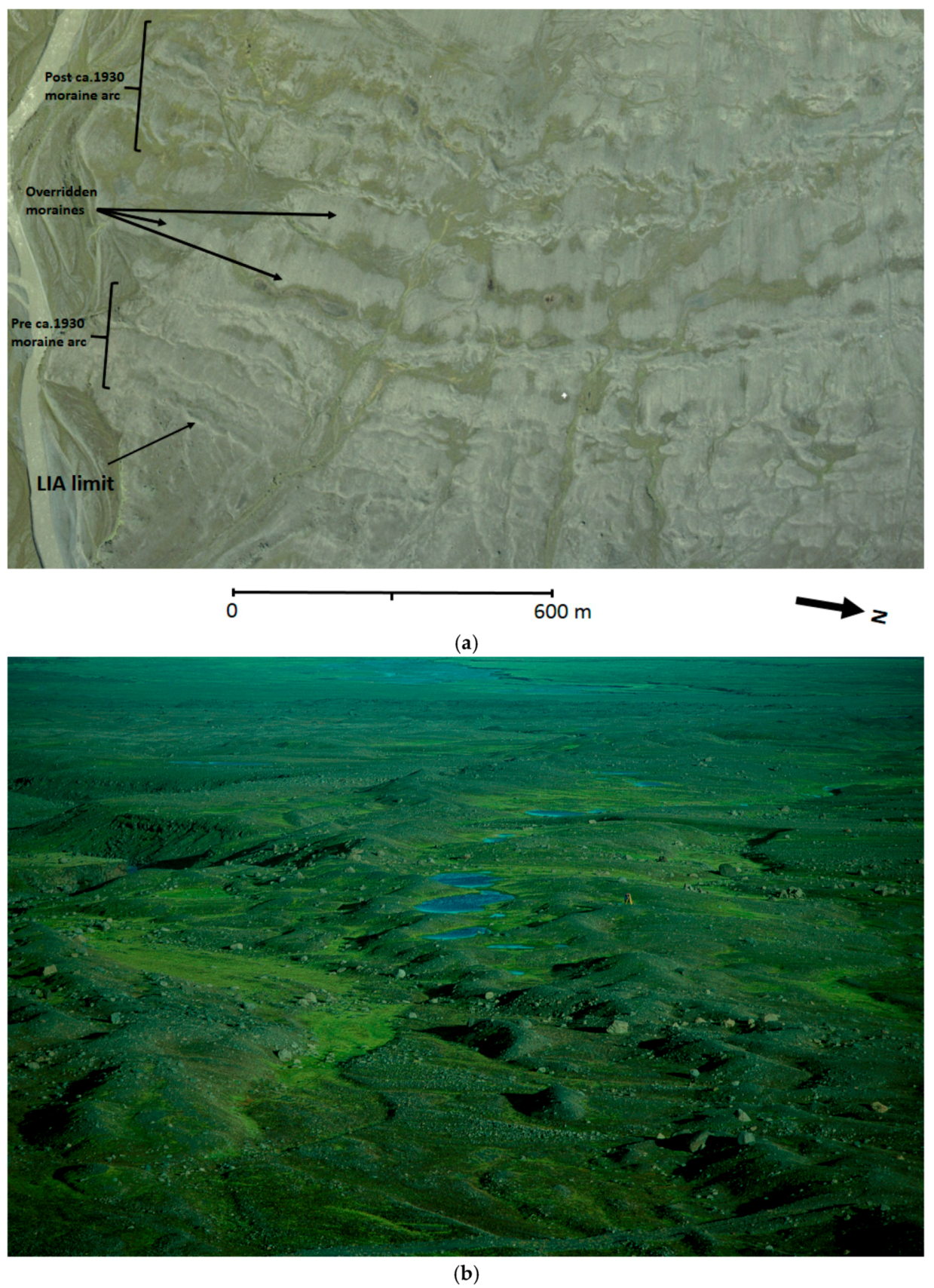
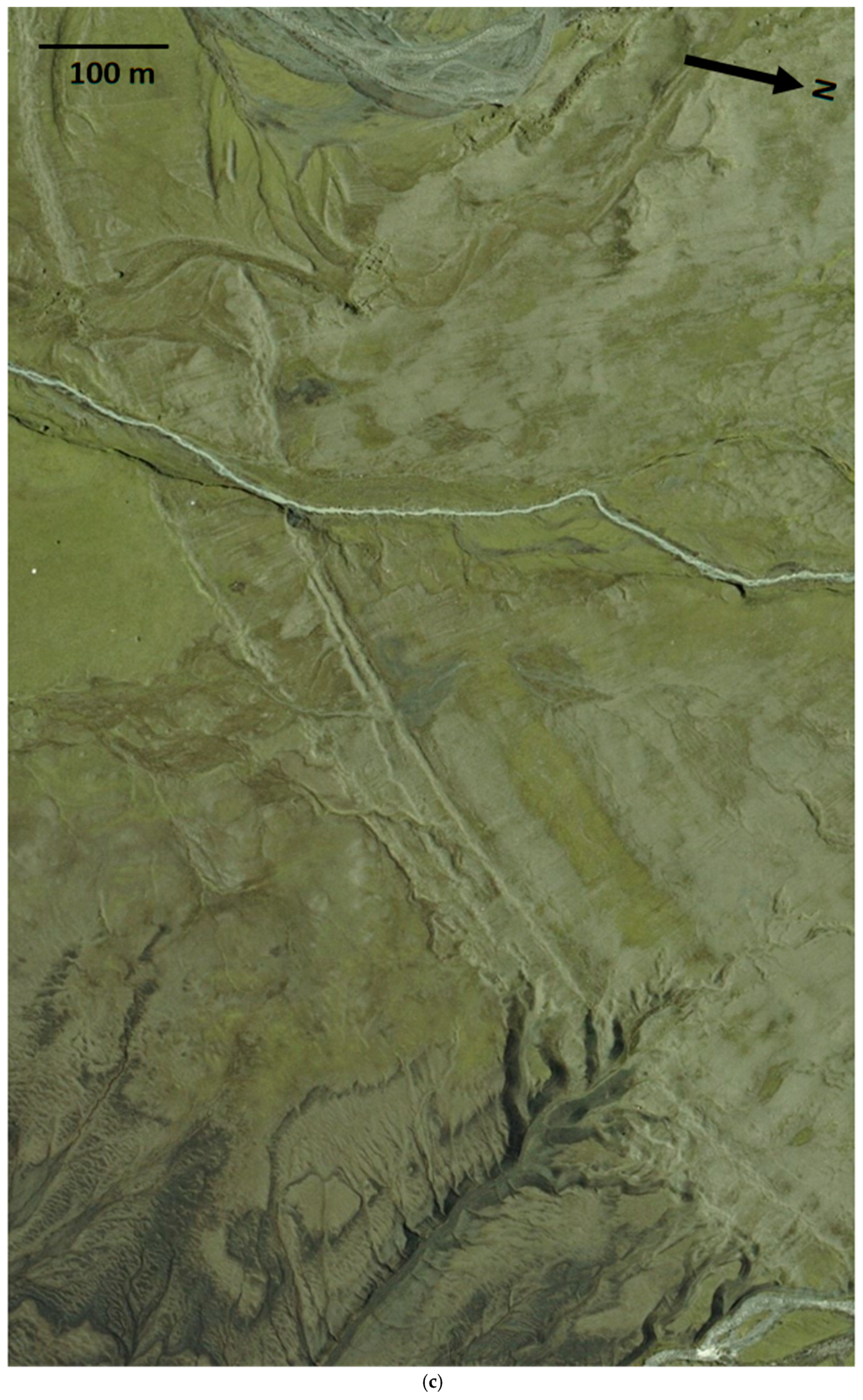
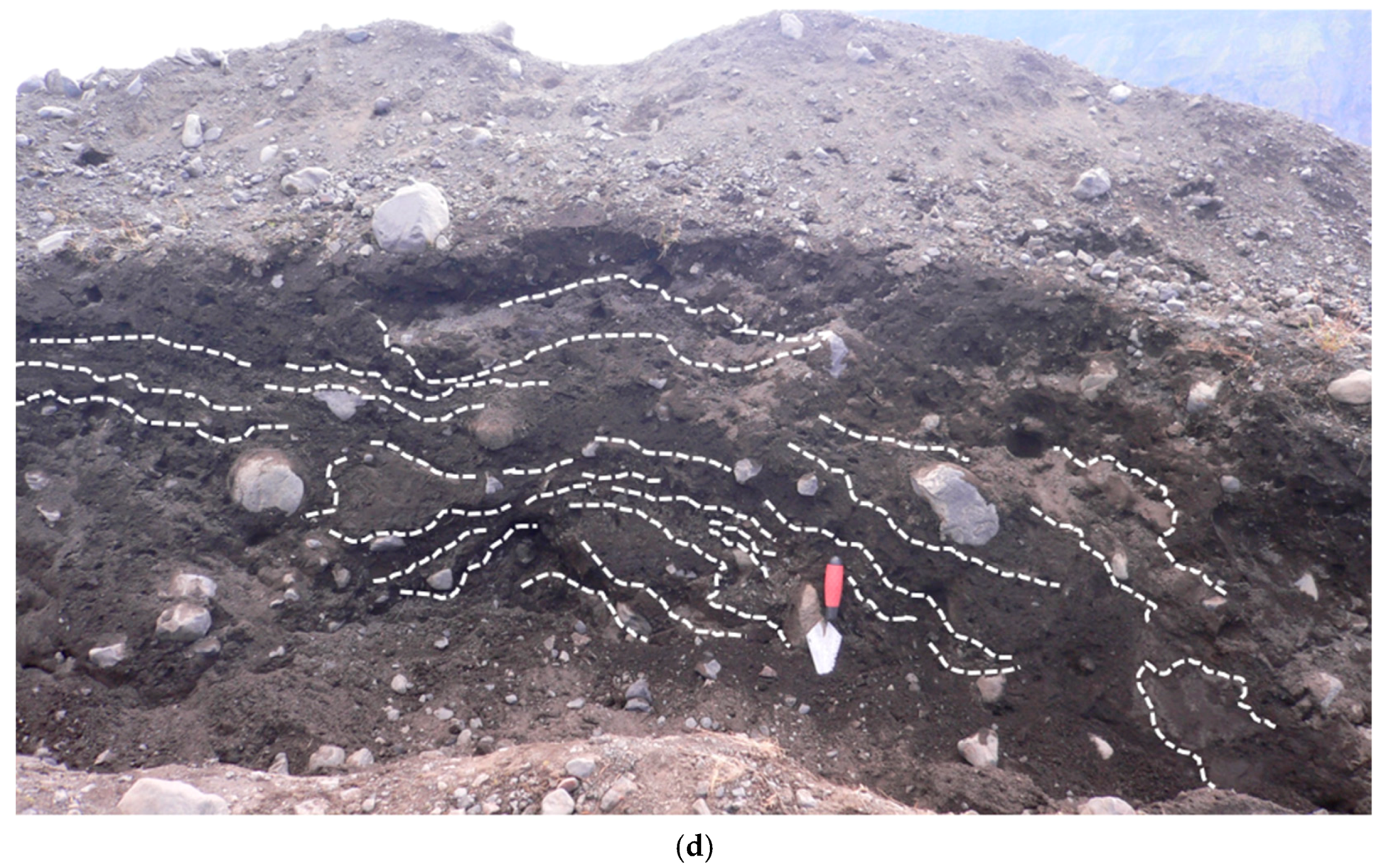
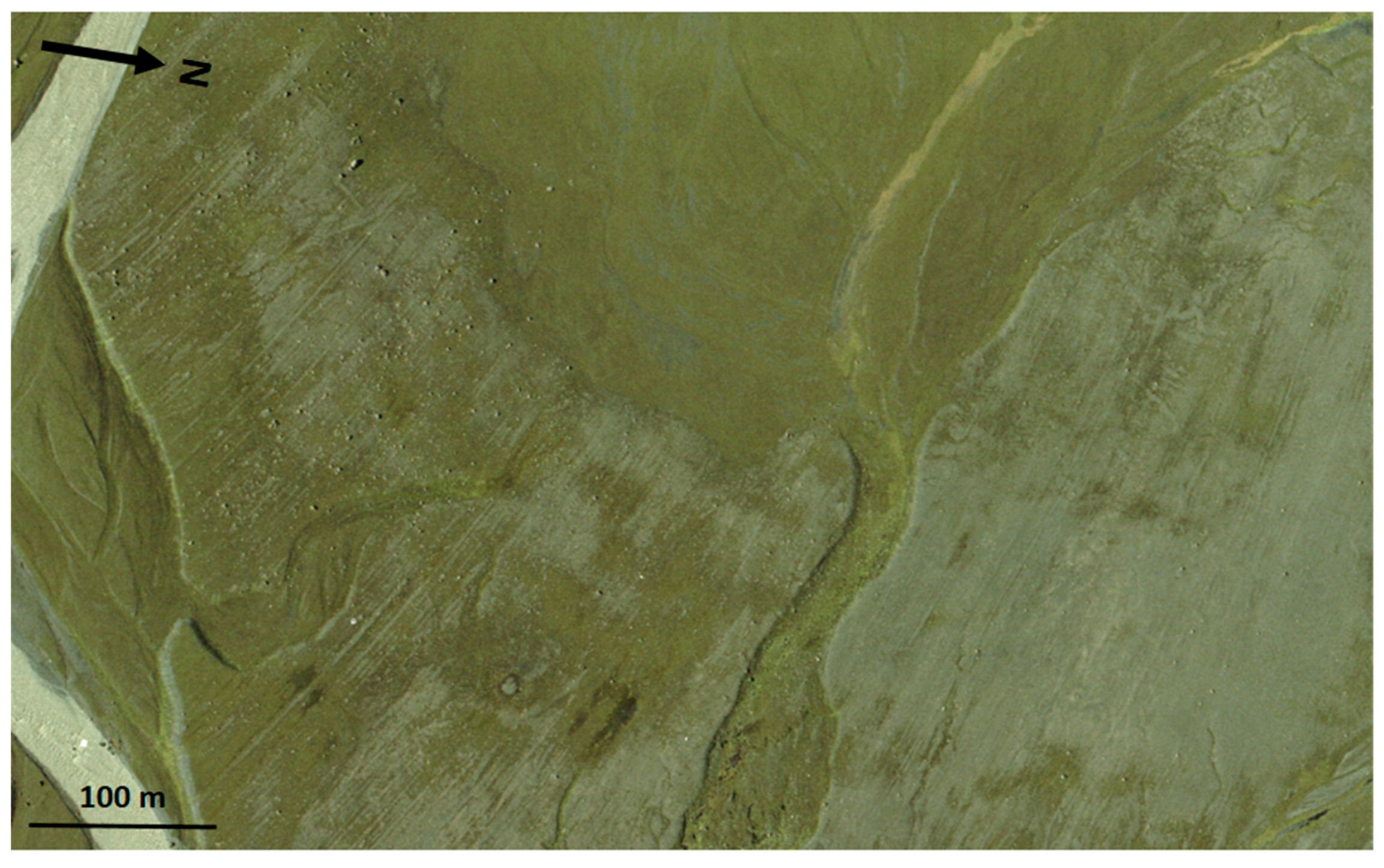
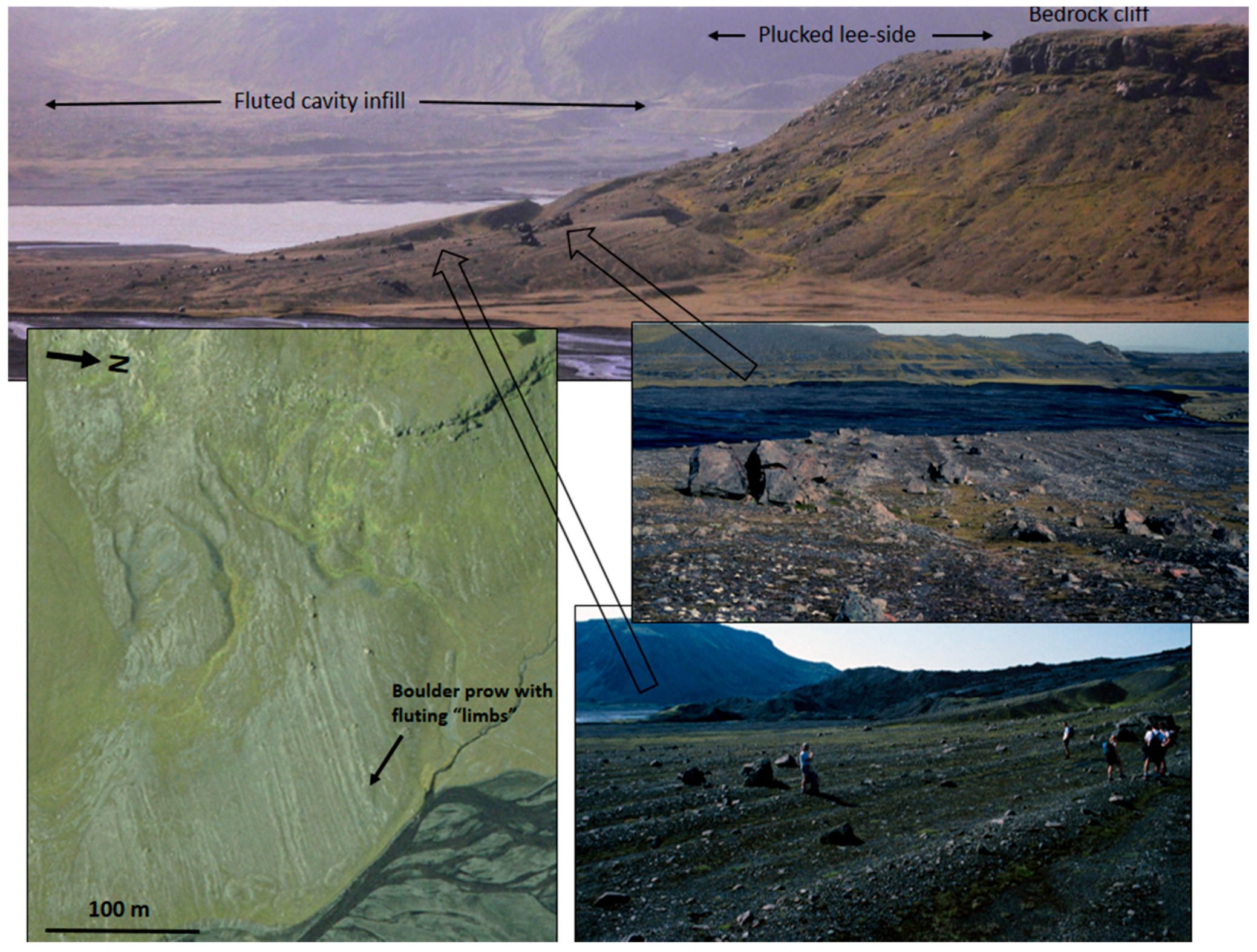
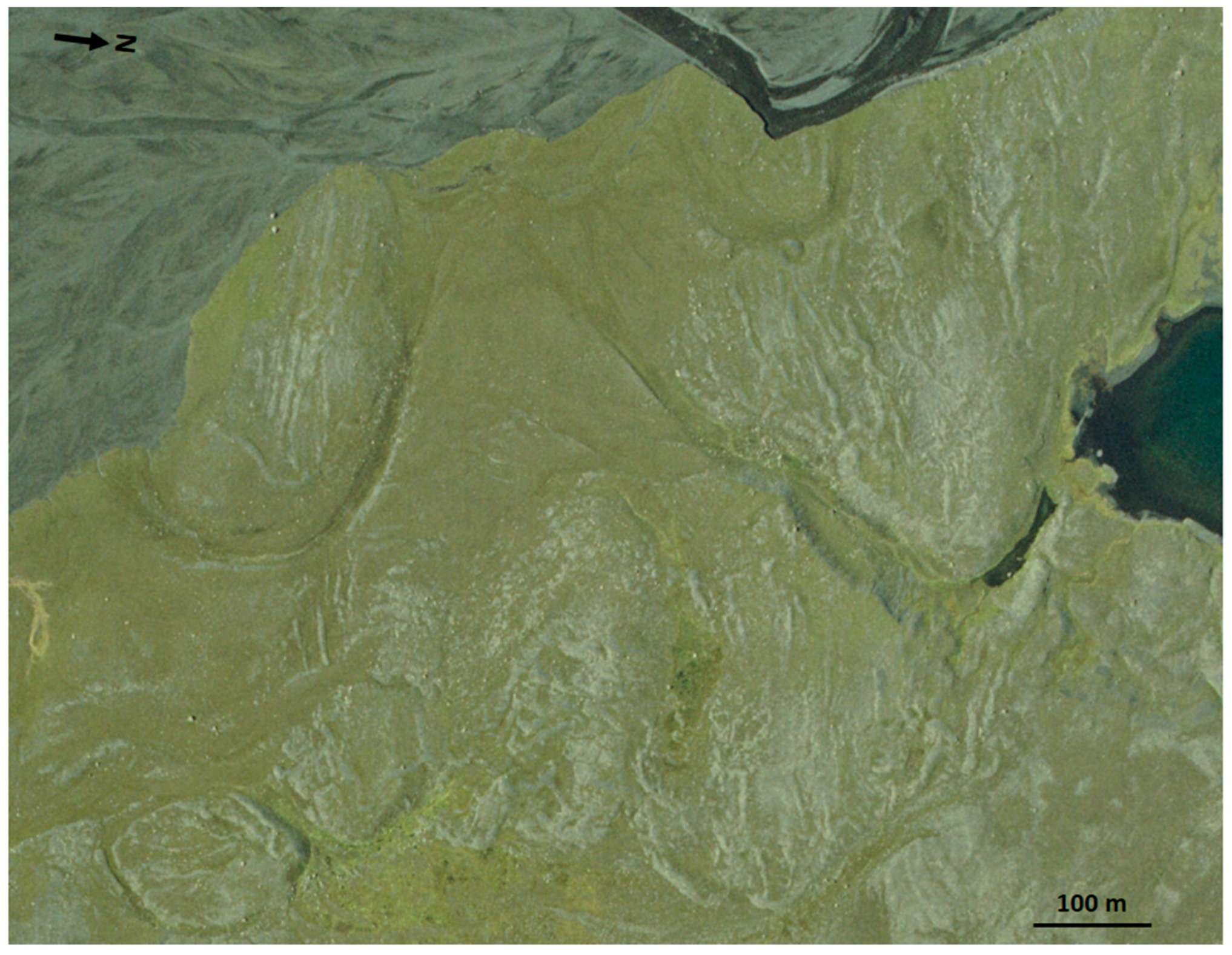
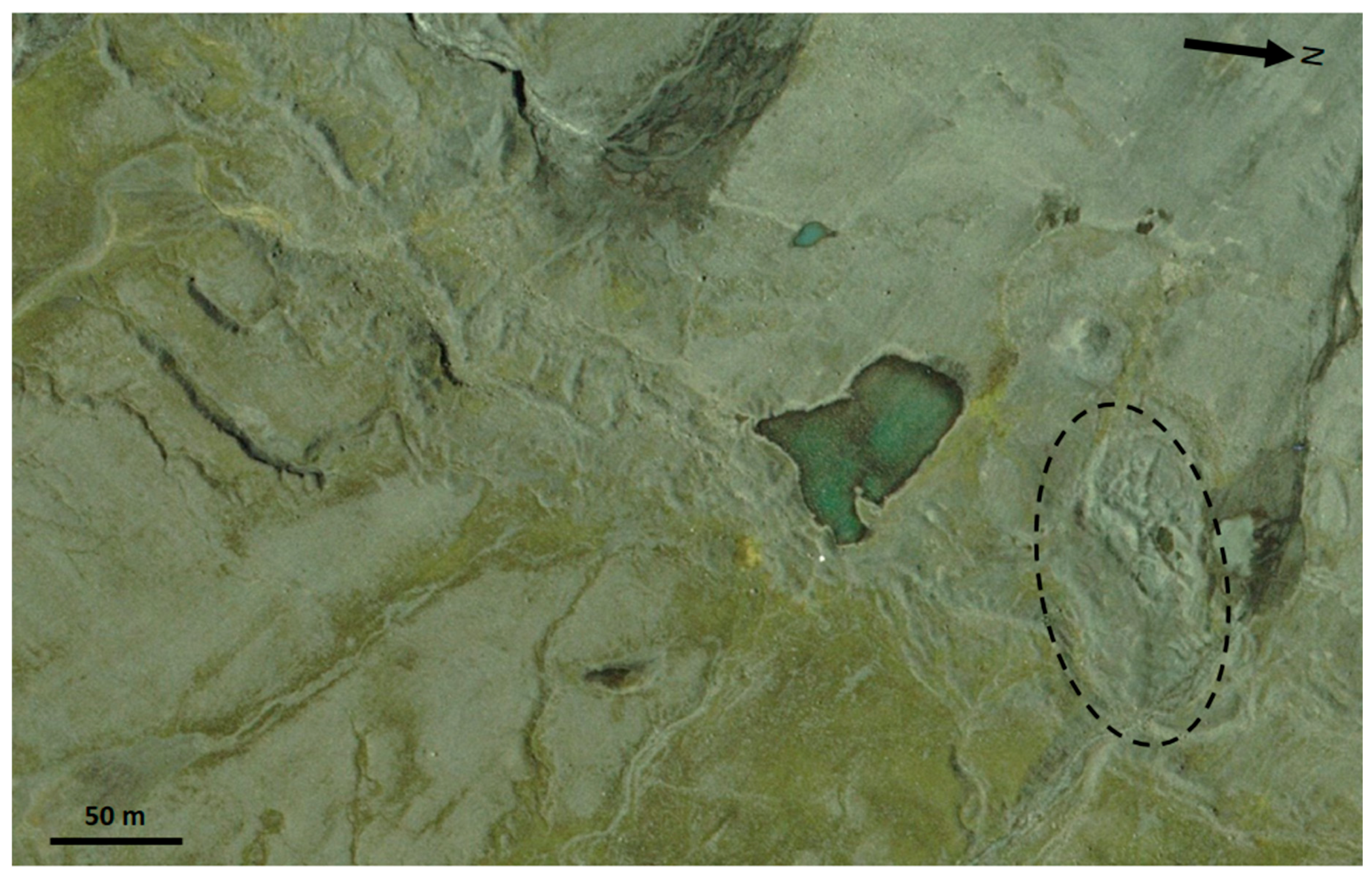
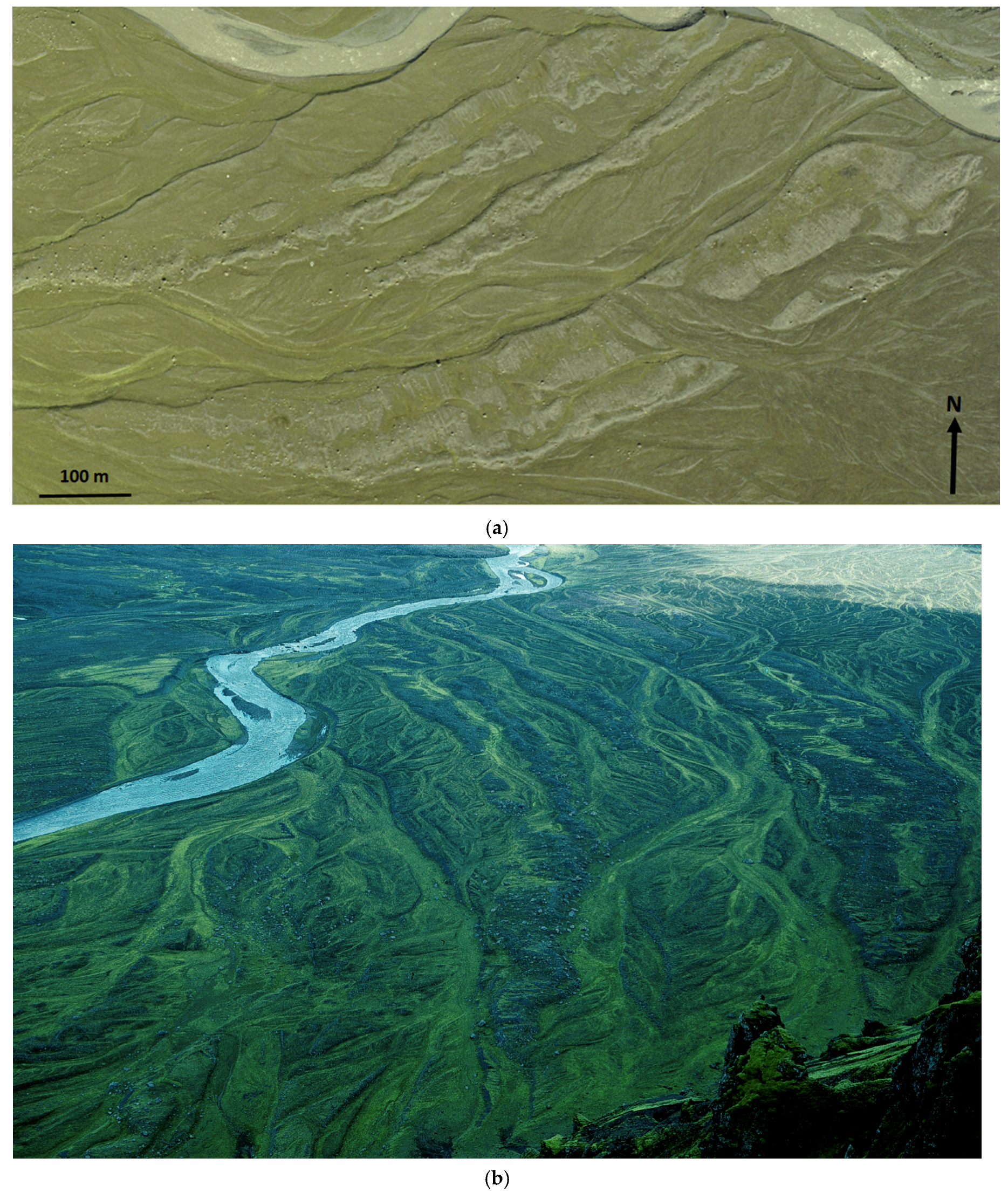
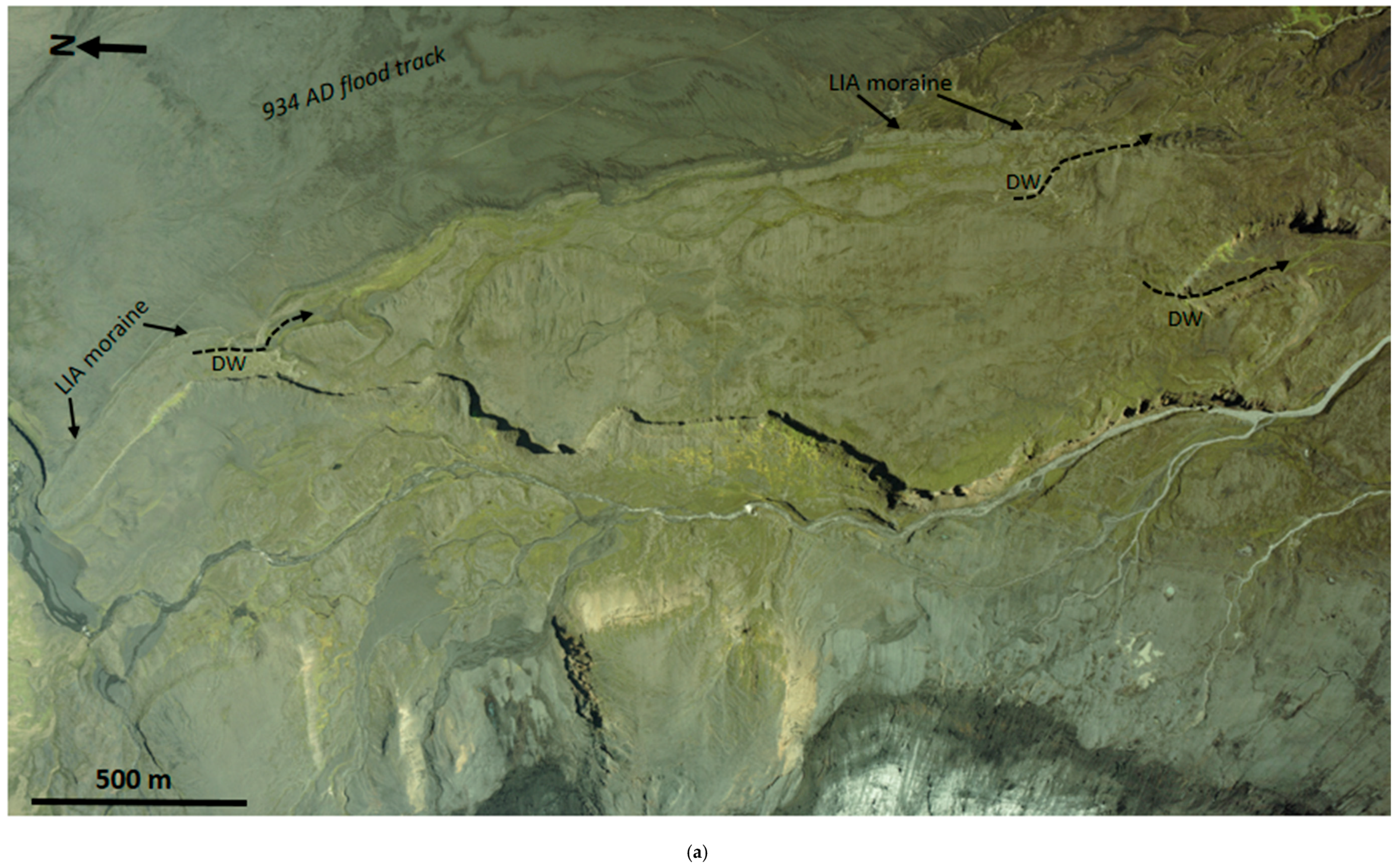
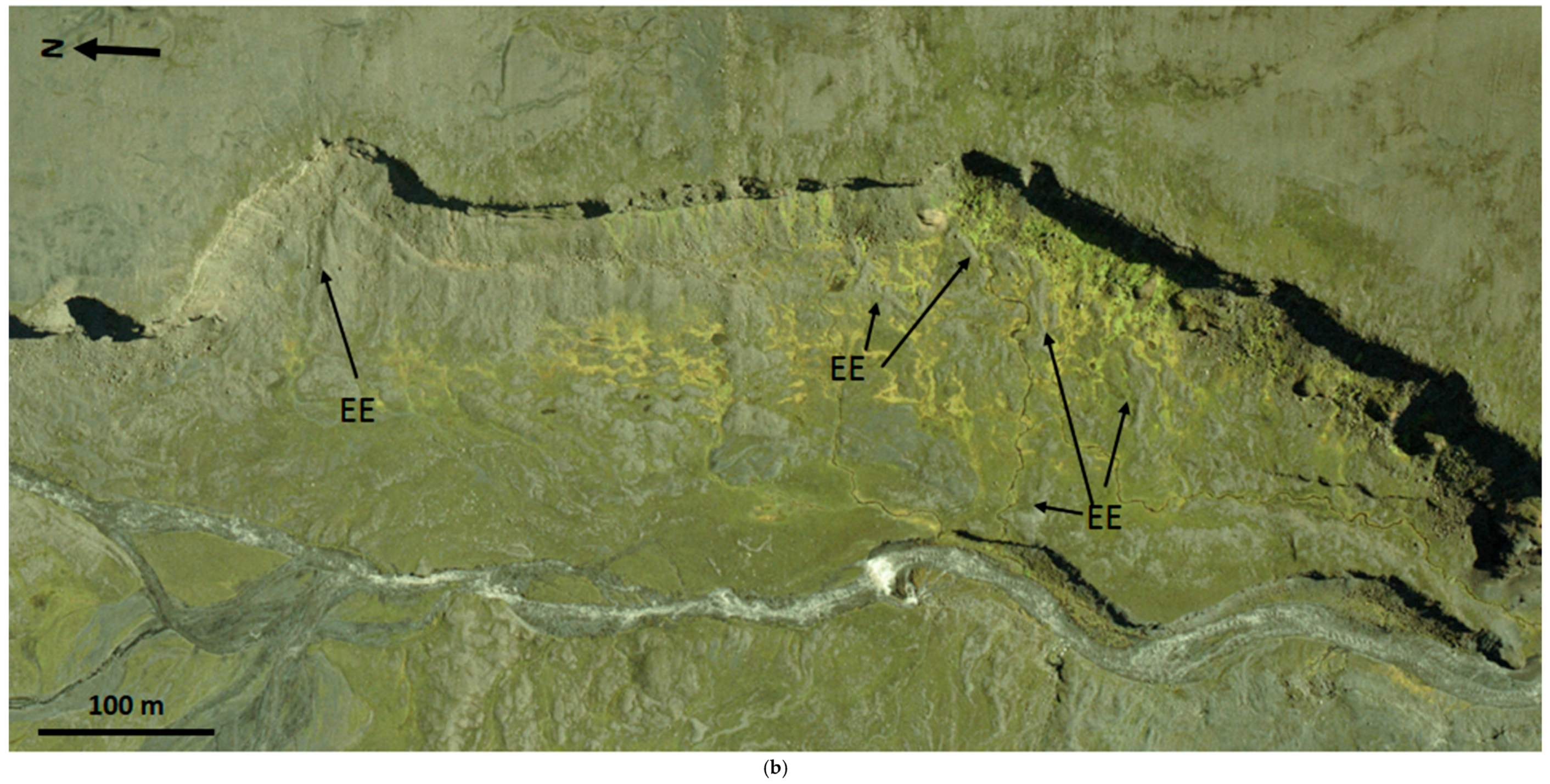
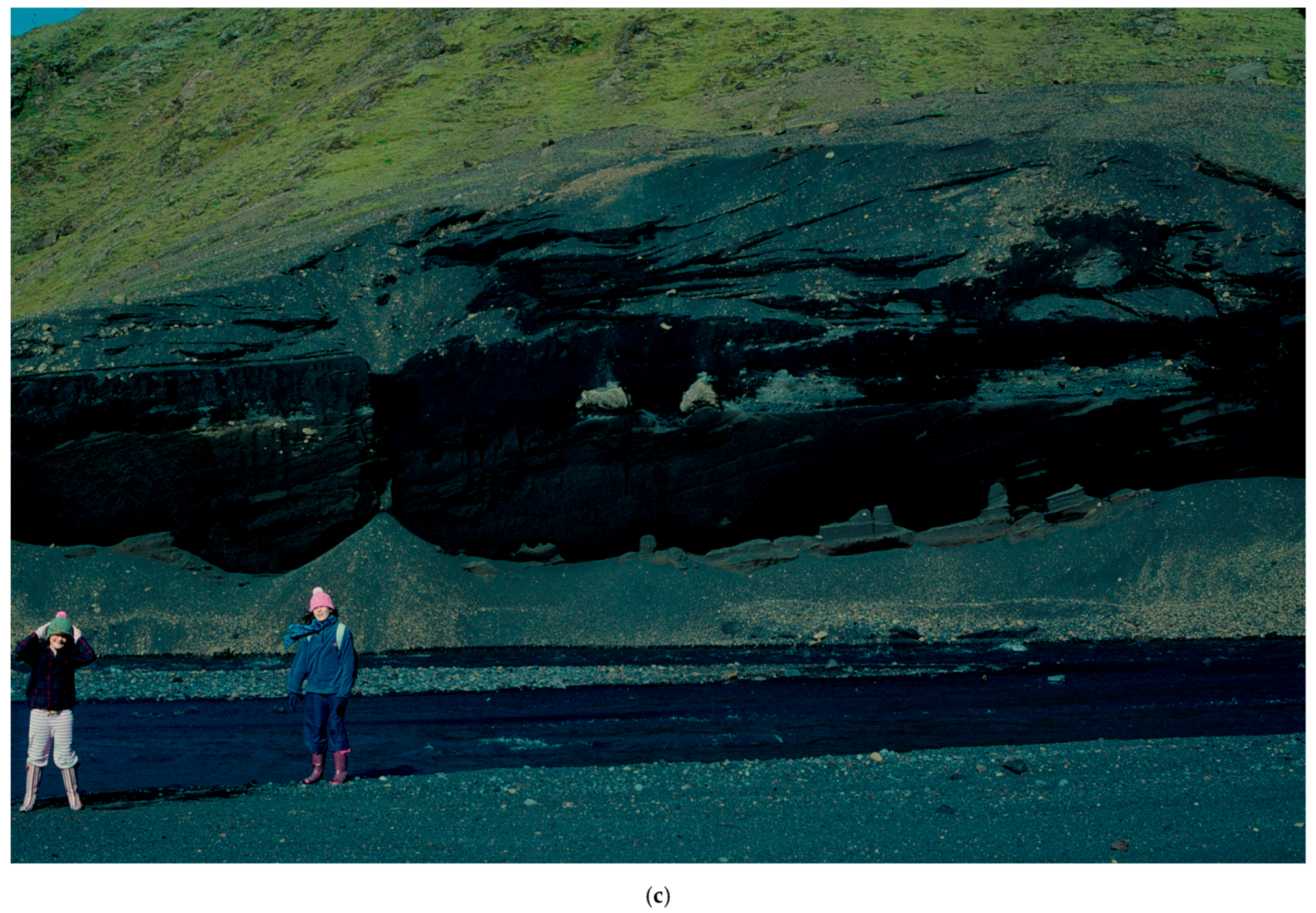
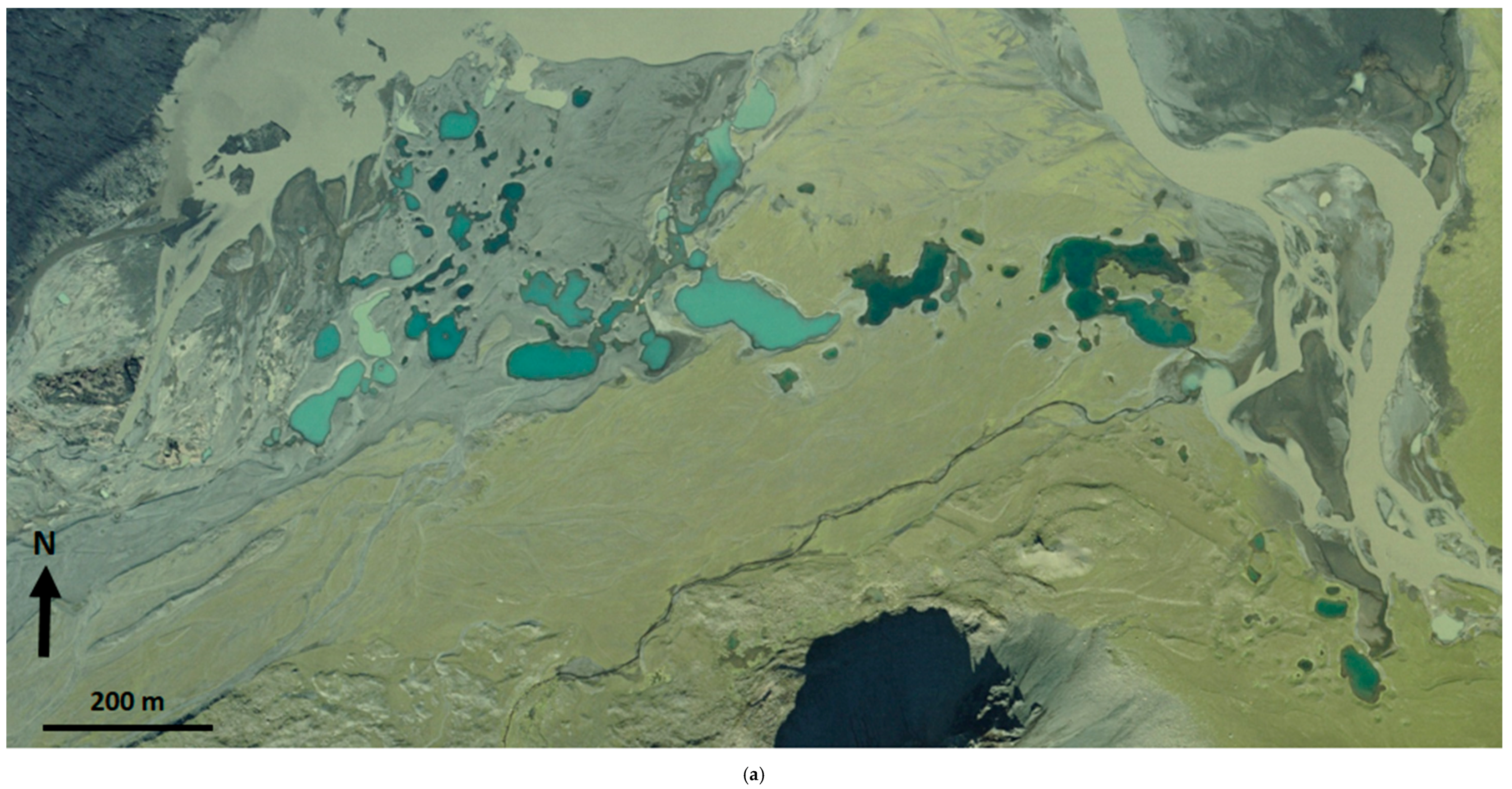
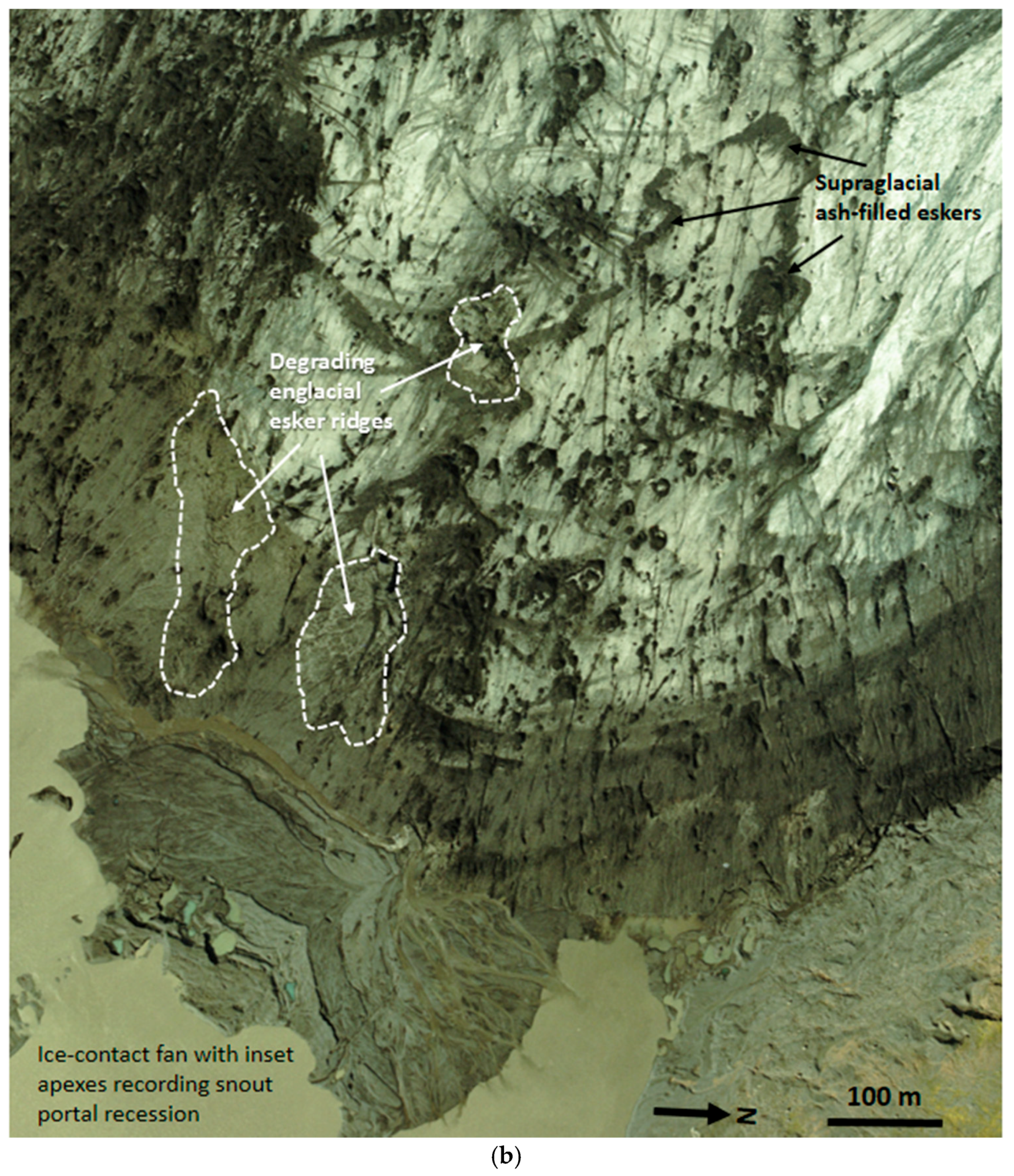
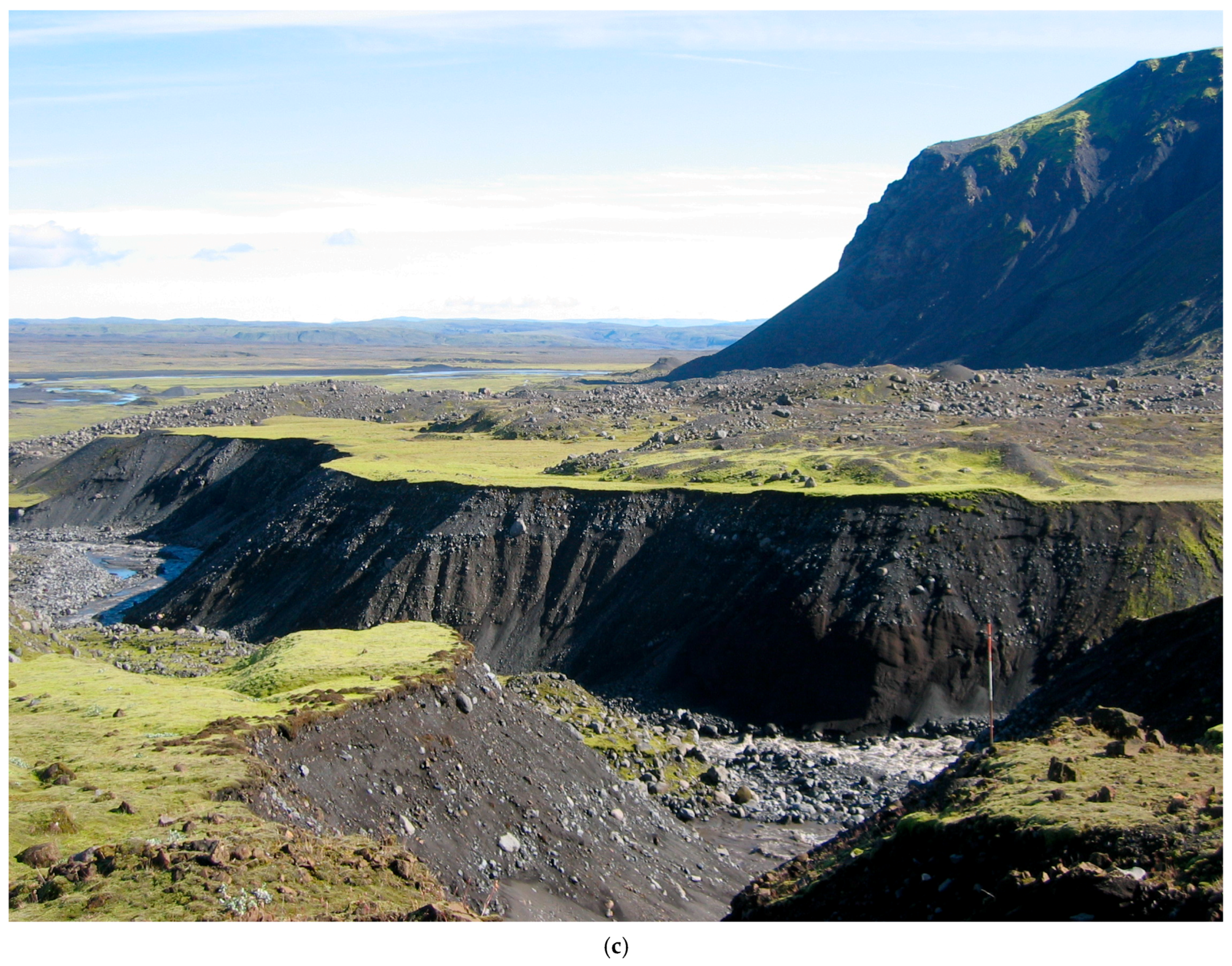
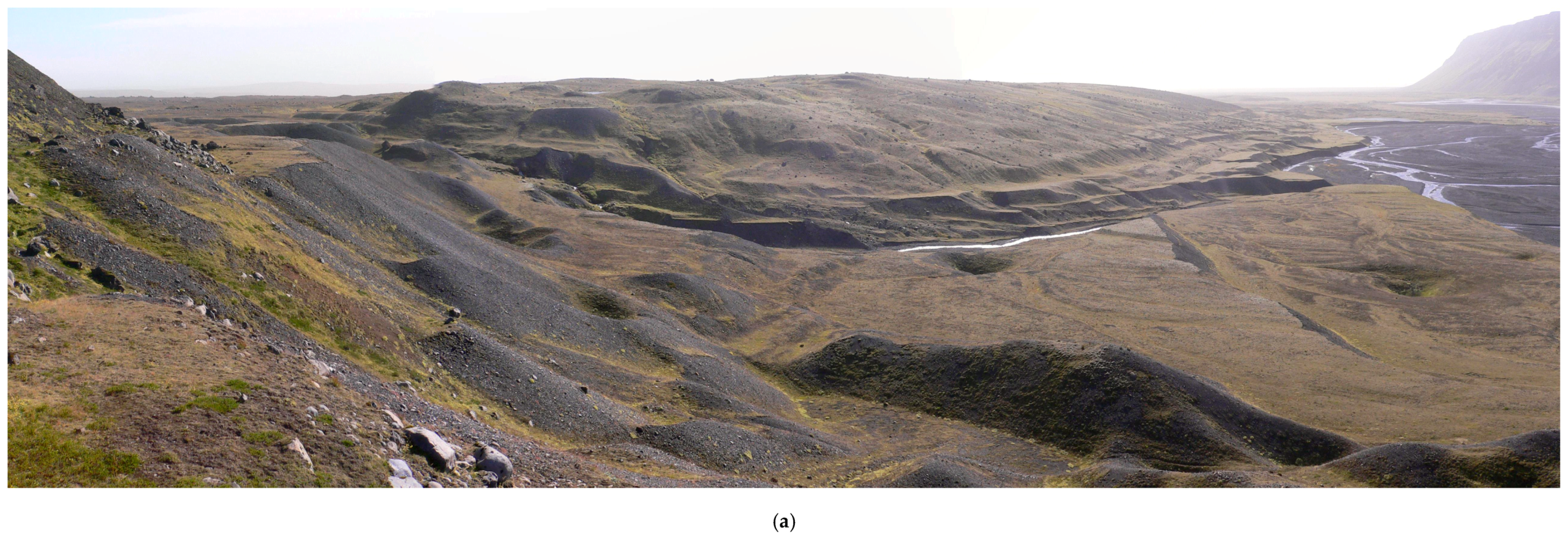
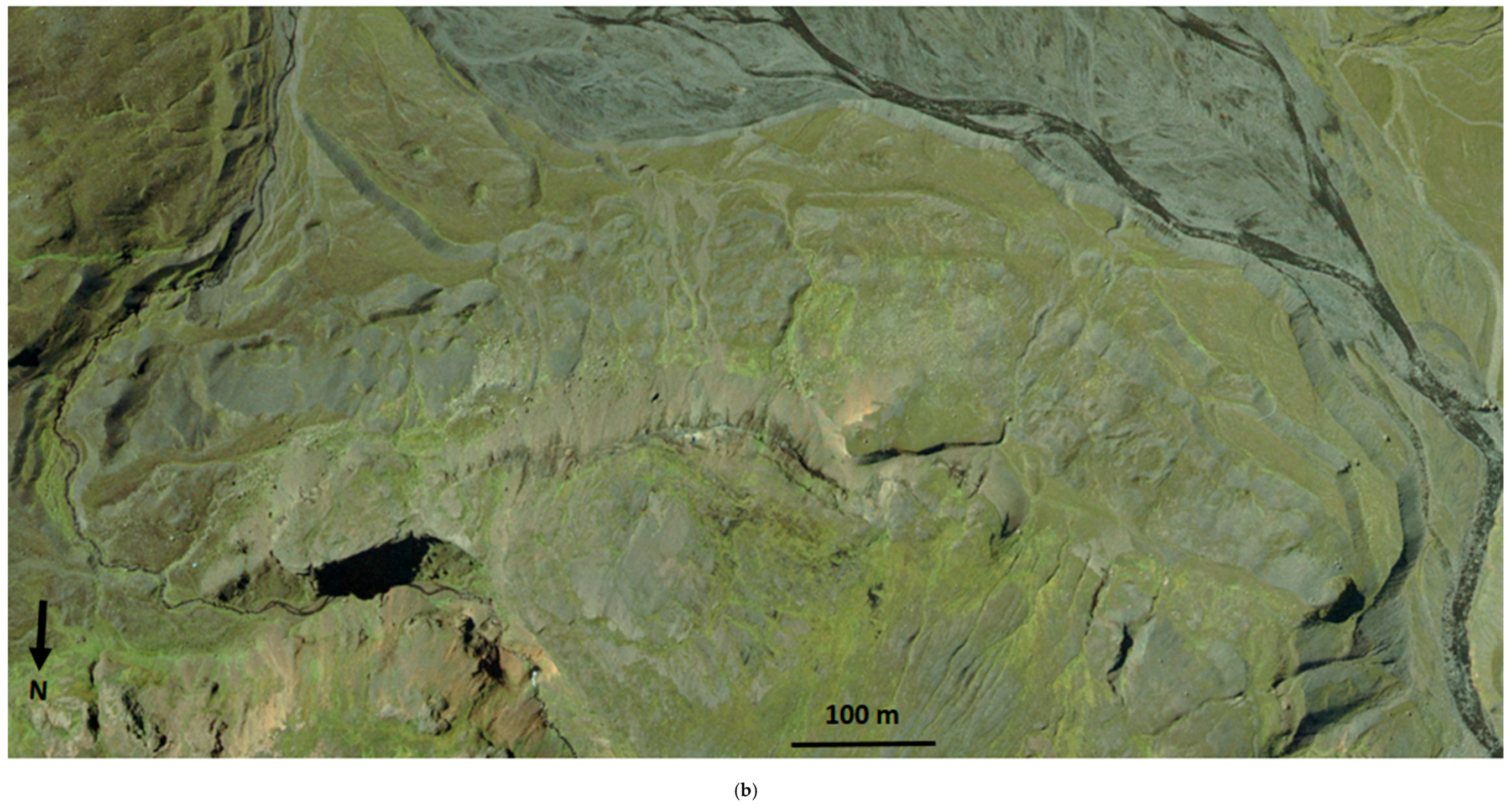
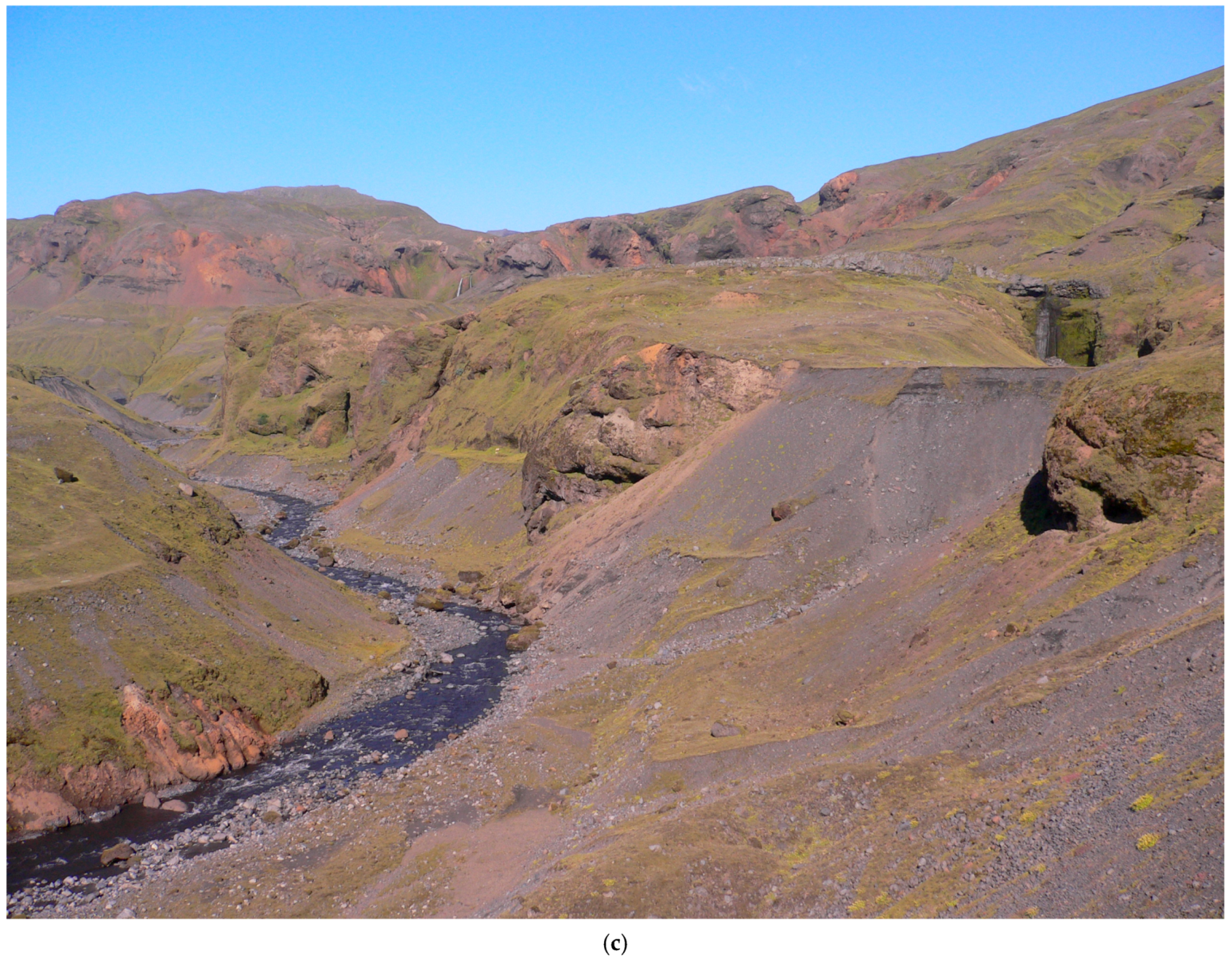
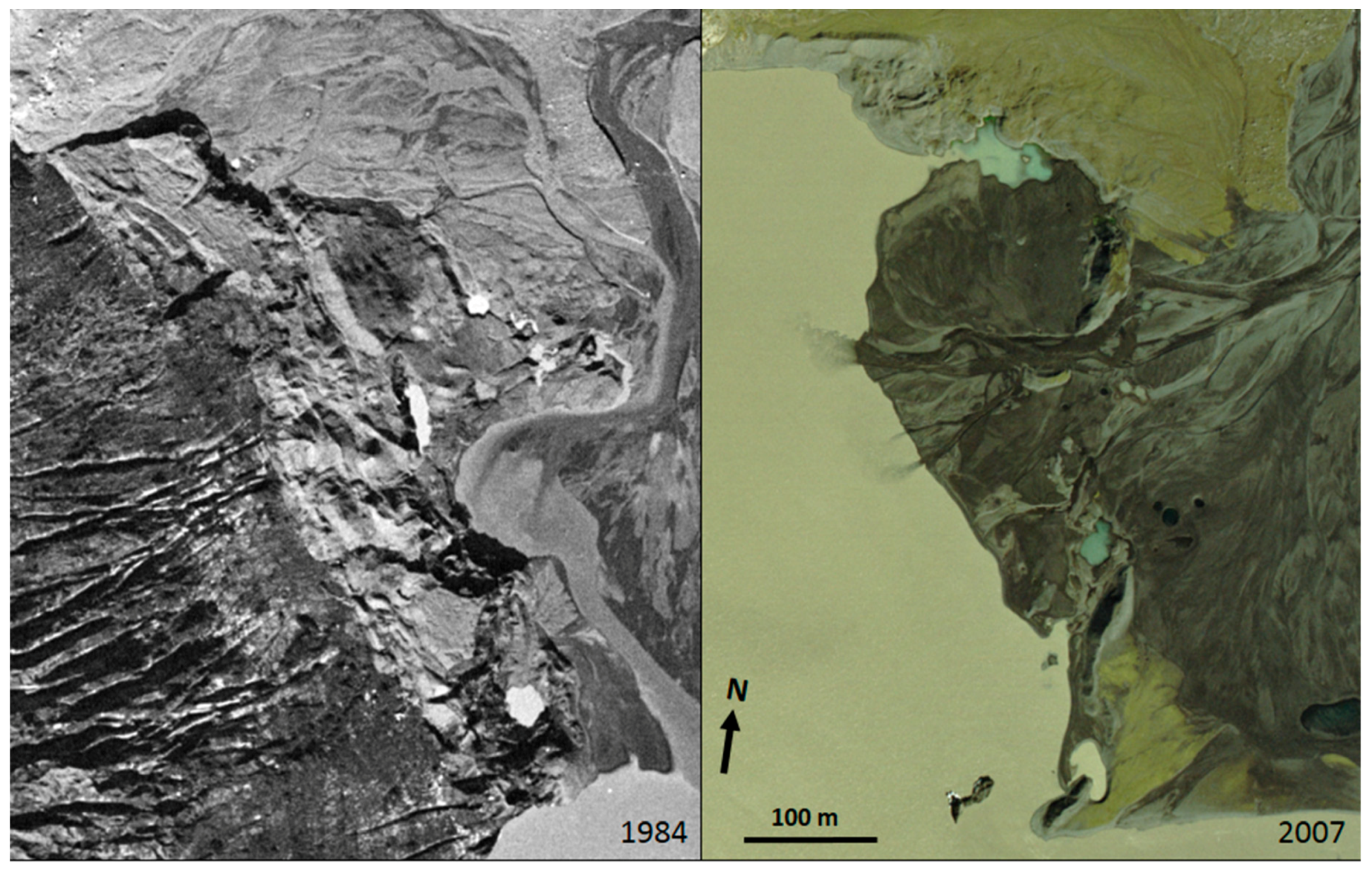
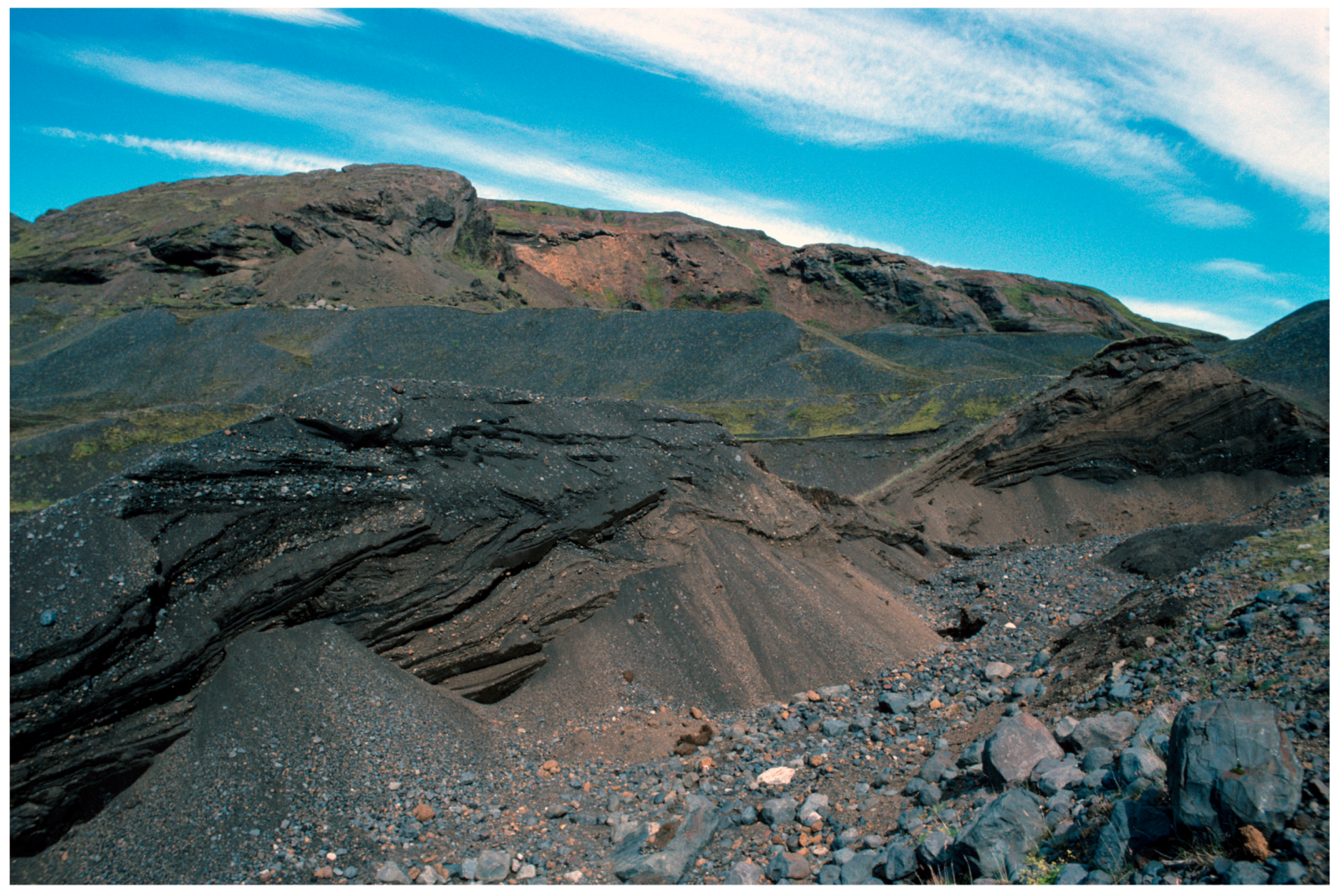
© 2018 by the authors. Licensee MDPI, Basel, Switzerland. This article is an open access article distributed under the terms and conditions of the Creative Commons Attribution (CC BY) license (http://creativecommons.org/licenses/by/4.0/).
Share and Cite
Evans, D.J.A.; Ewertowski, M.; Orton, C.; Graham, D.J. The Glacial Geomorphology of the Ice Cap Piedmont Lobe Landsystem of East Mýrdalsjökull, Iceland. Geosciences 2018, 8, 194. https://doi.org/10.3390/geosciences8060194
Evans DJA, Ewertowski M, Orton C, Graham DJ. The Glacial Geomorphology of the Ice Cap Piedmont Lobe Landsystem of East Mýrdalsjökull, Iceland. Geosciences. 2018; 8(6):194. https://doi.org/10.3390/geosciences8060194
Chicago/Turabian StyleEvans, David J. A., Marek Ewertowski, Chris Orton, and David J. Graham. 2018. "The Glacial Geomorphology of the Ice Cap Piedmont Lobe Landsystem of East Mýrdalsjökull, Iceland" Geosciences 8, no. 6: 194. https://doi.org/10.3390/geosciences8060194
APA StyleEvans, D. J. A., Ewertowski, M., Orton, C., & Graham, D. J. (2018). The Glacial Geomorphology of the Ice Cap Piedmont Lobe Landsystem of East Mýrdalsjökull, Iceland. Geosciences, 8(6), 194. https://doi.org/10.3390/geosciences8060194




